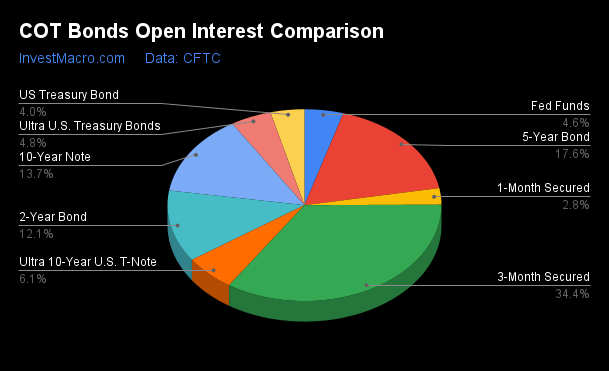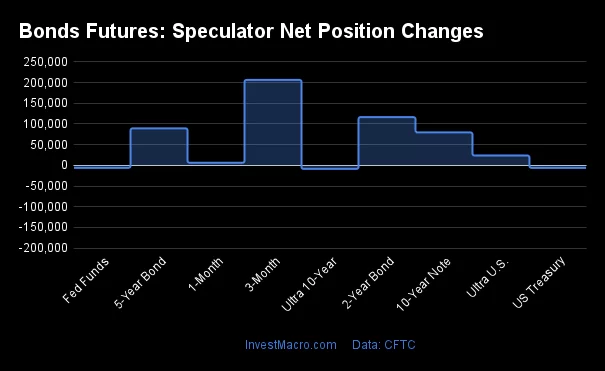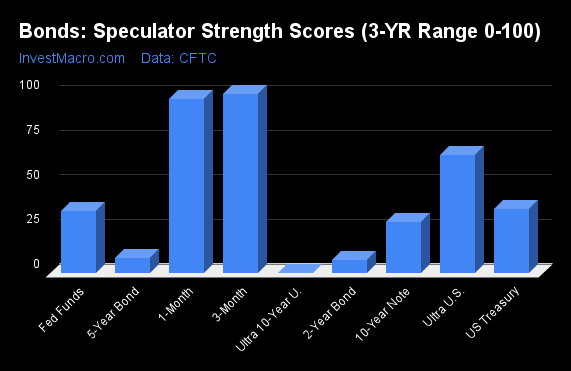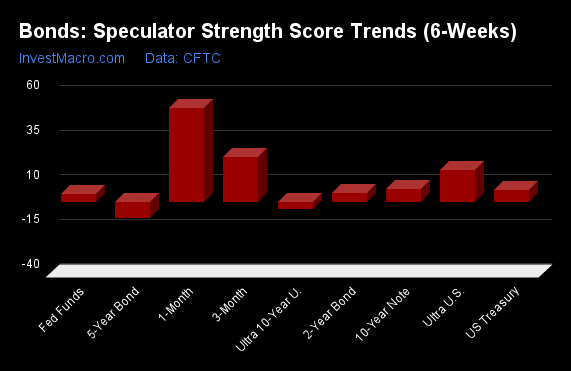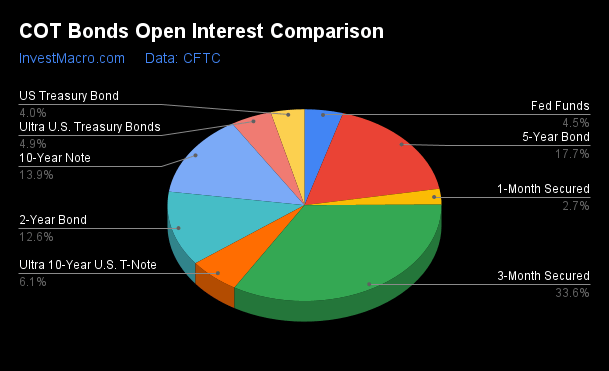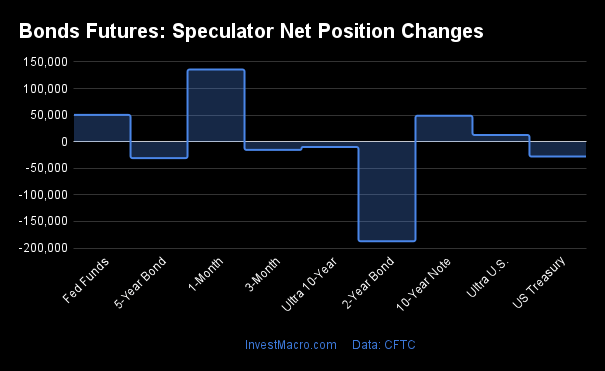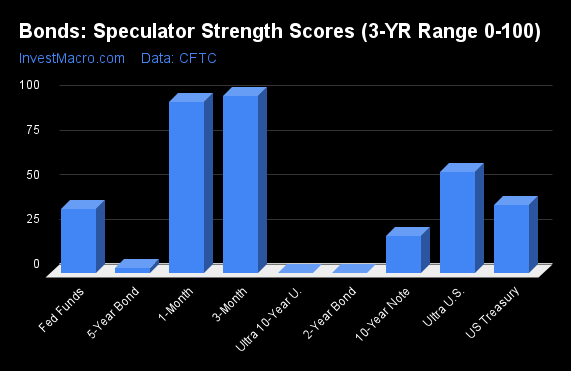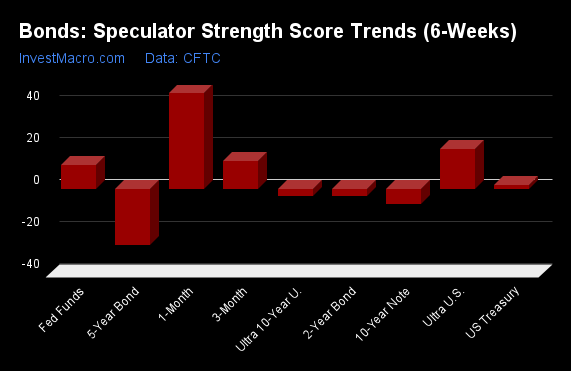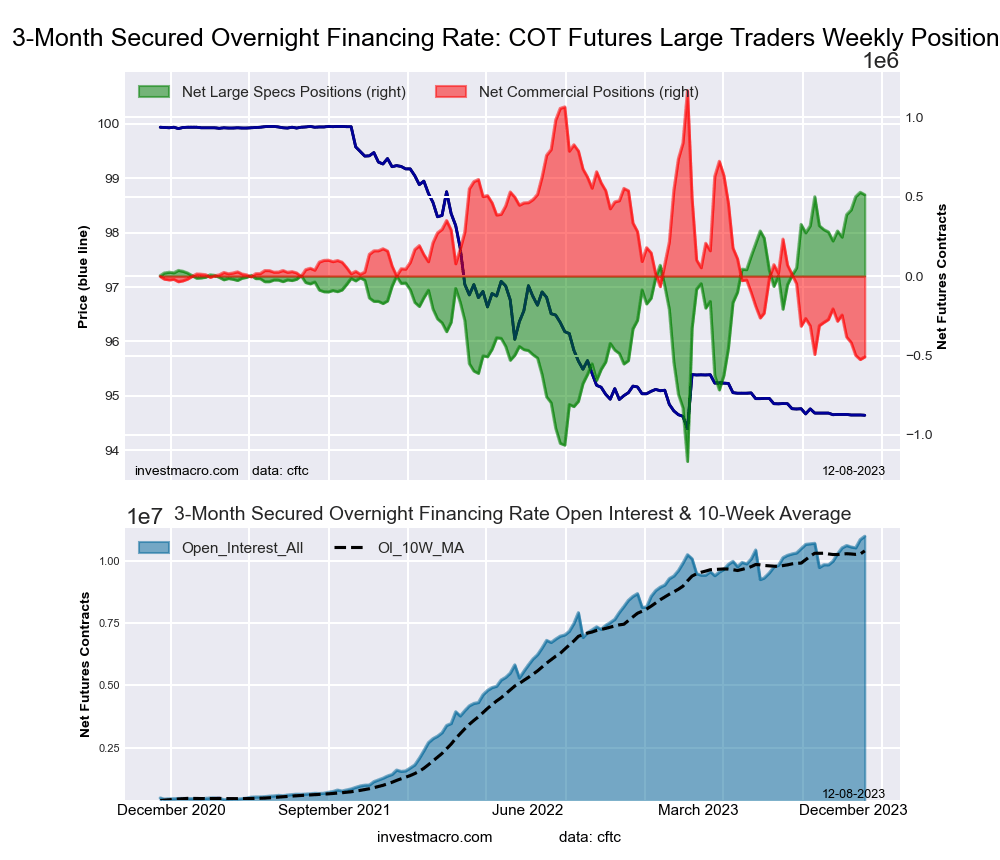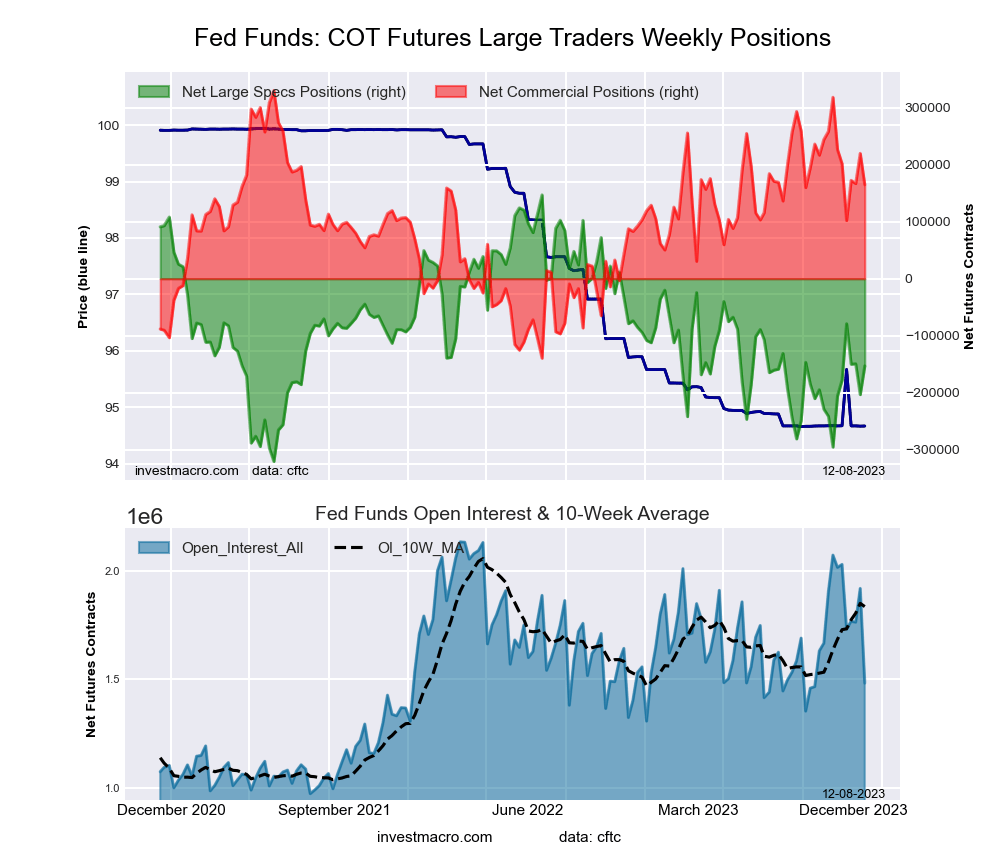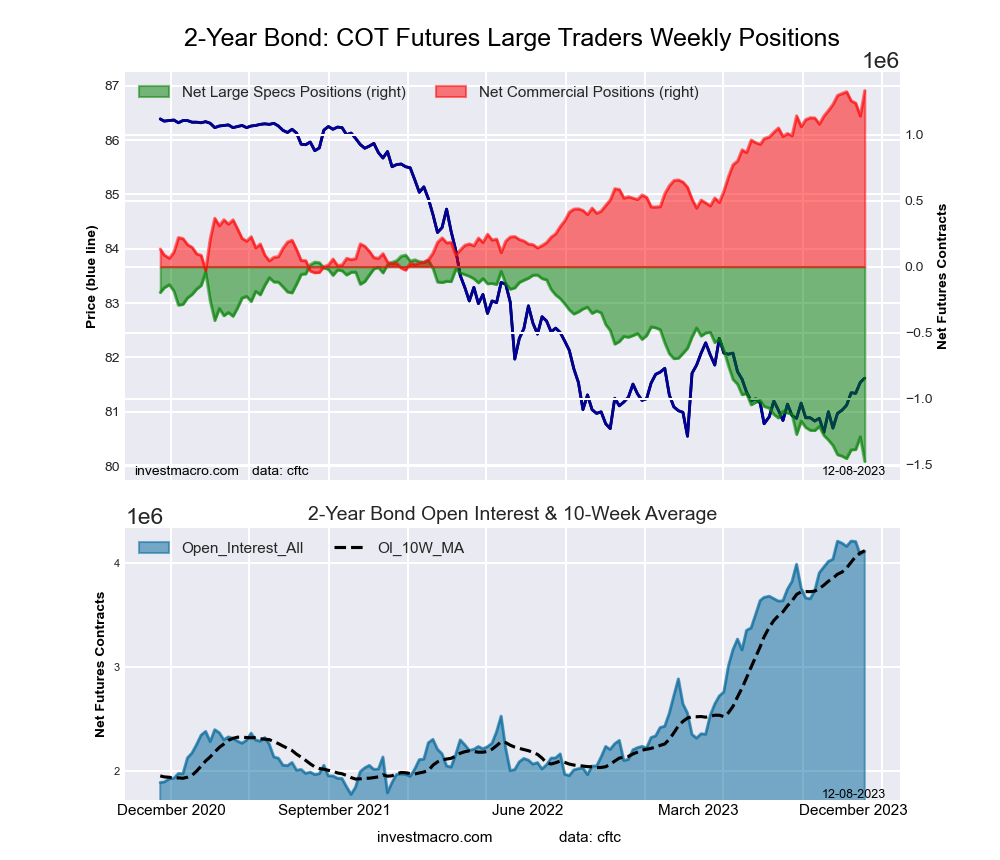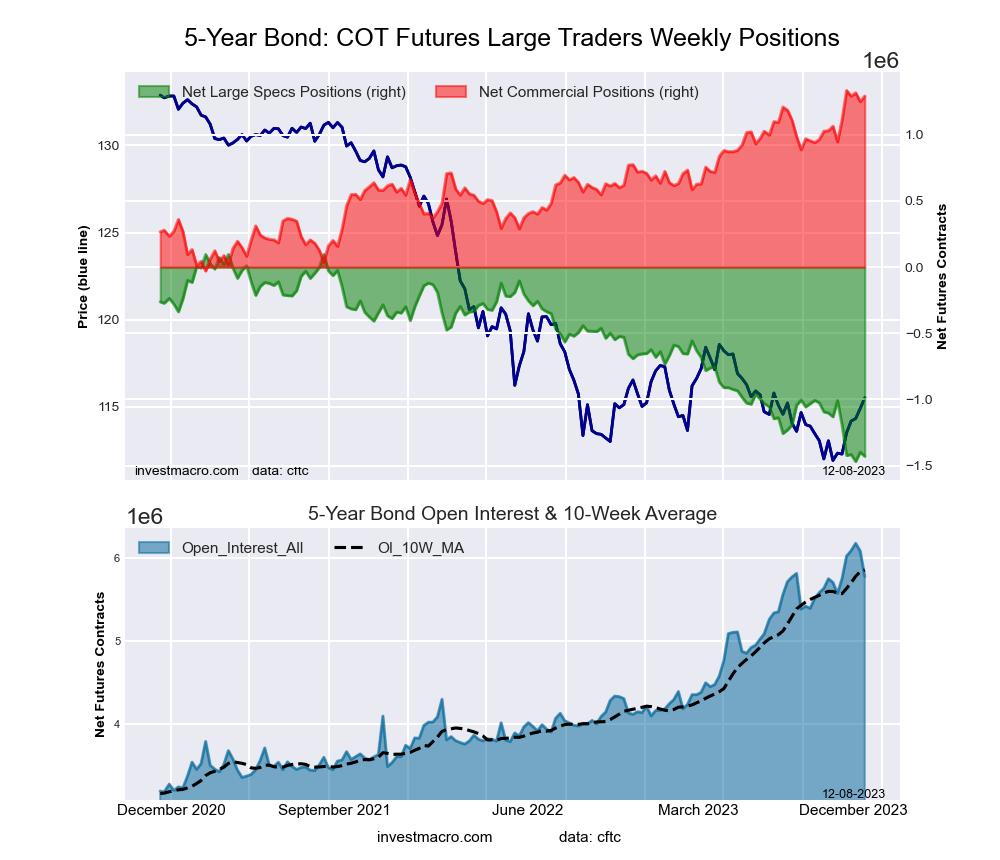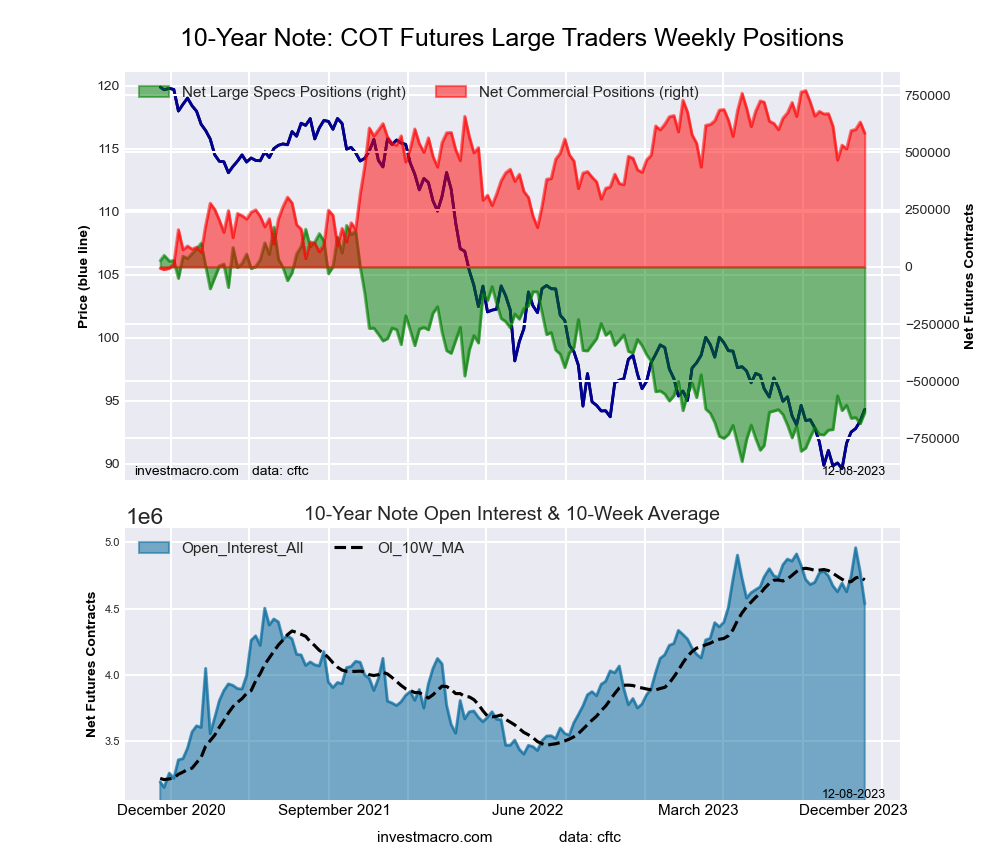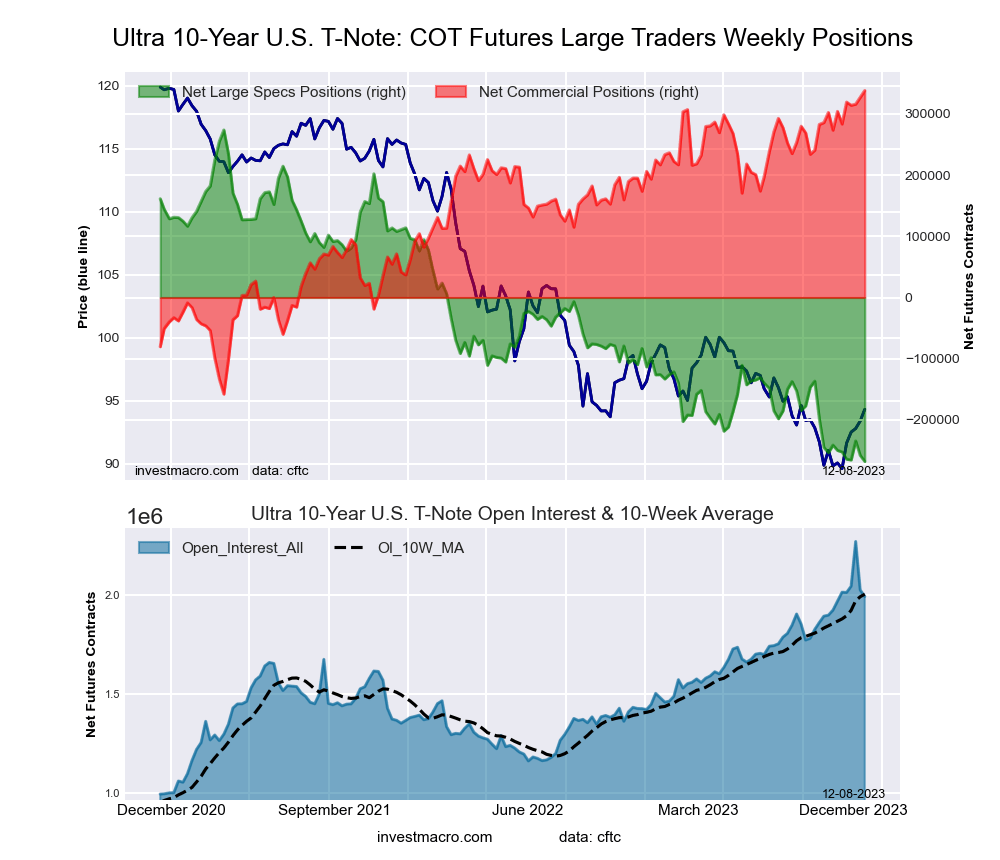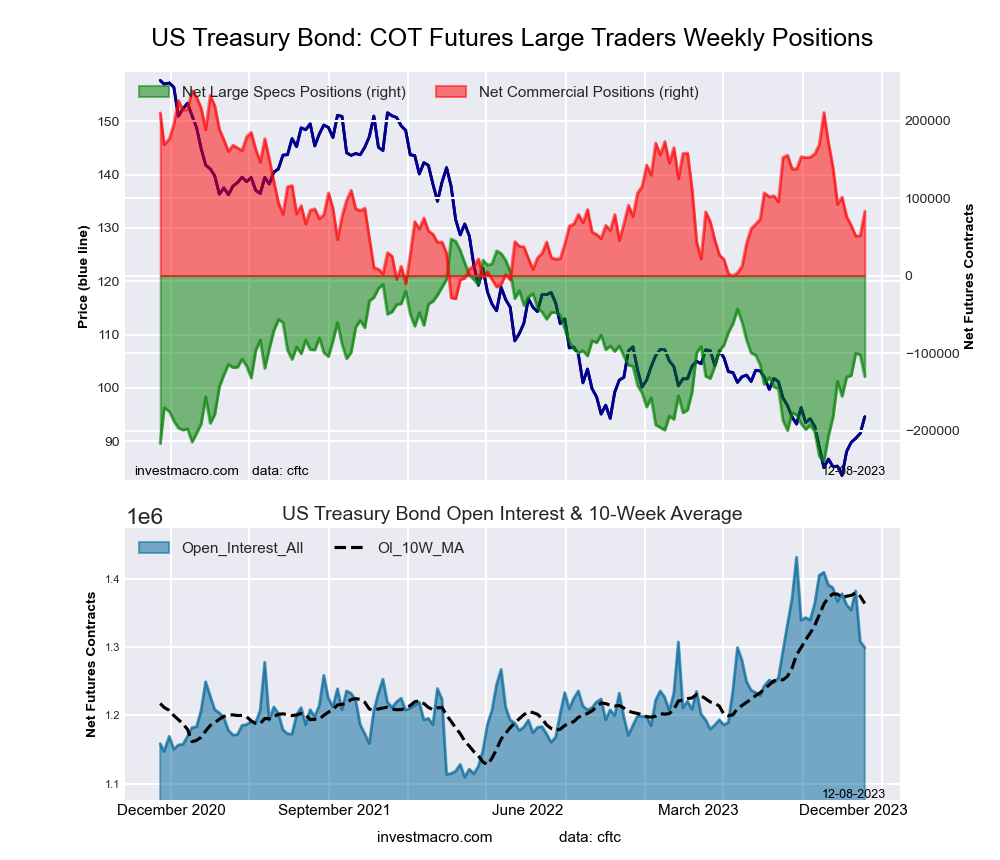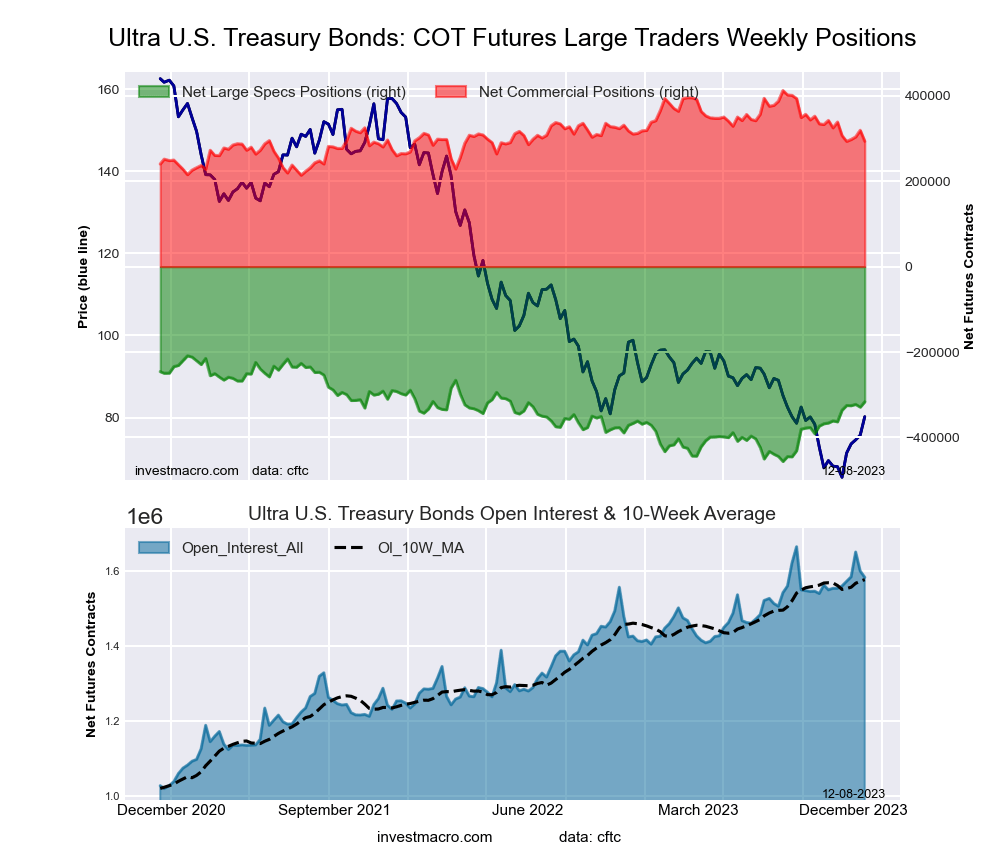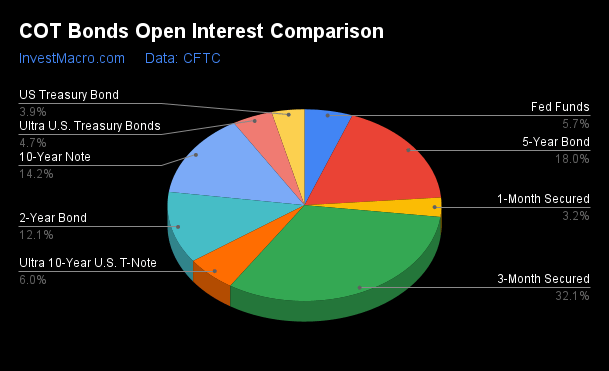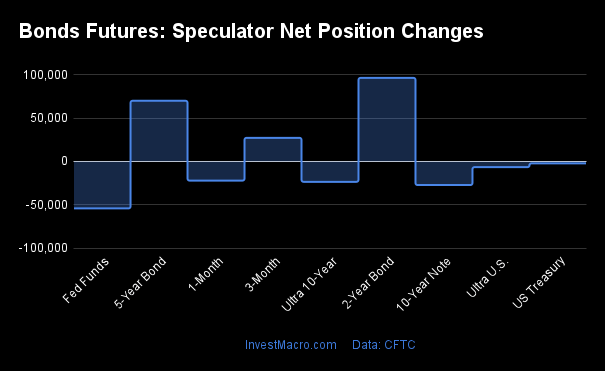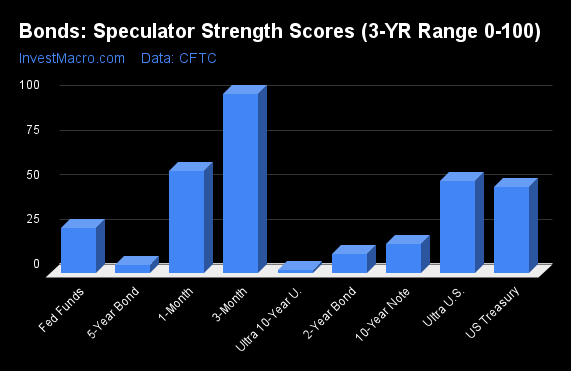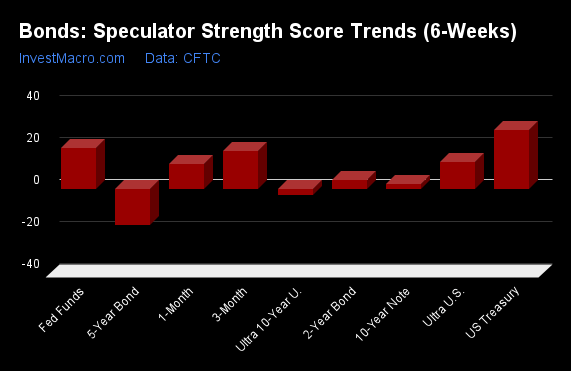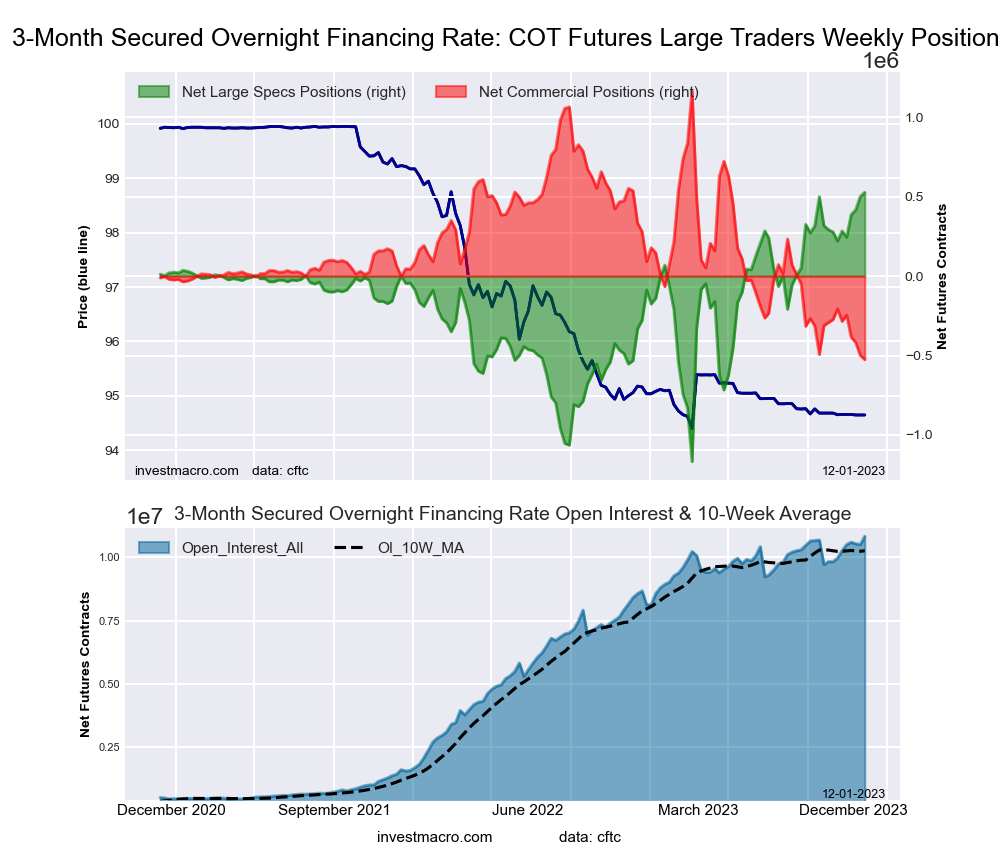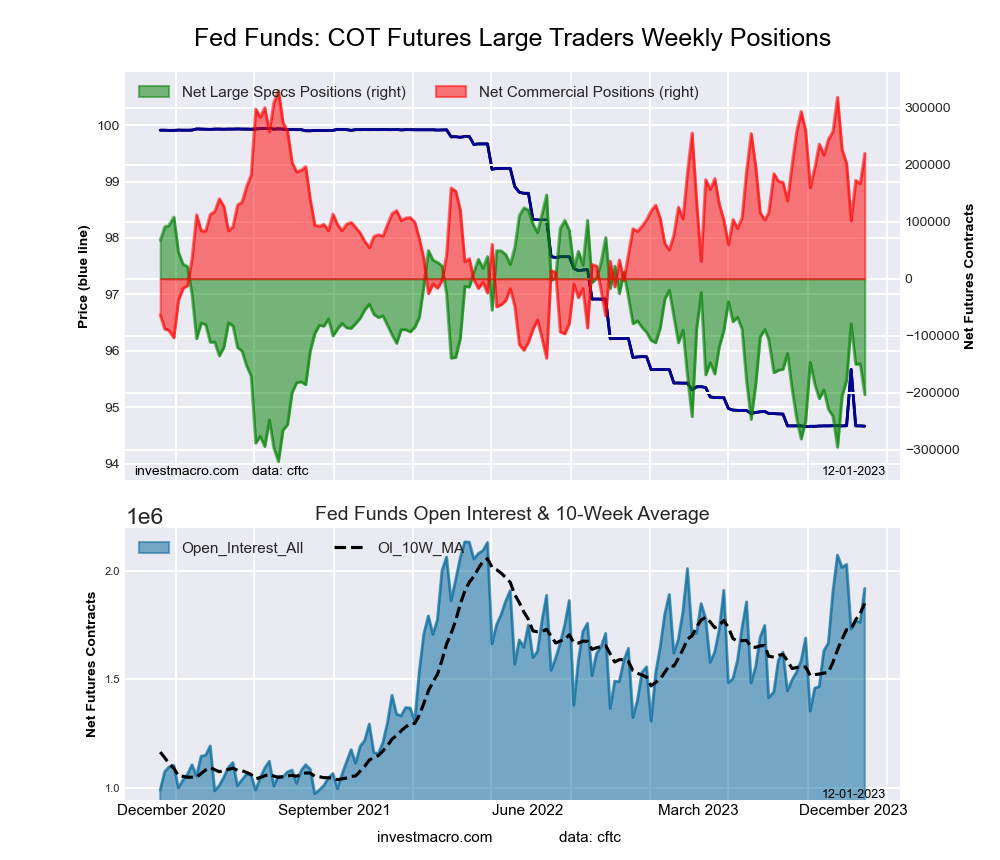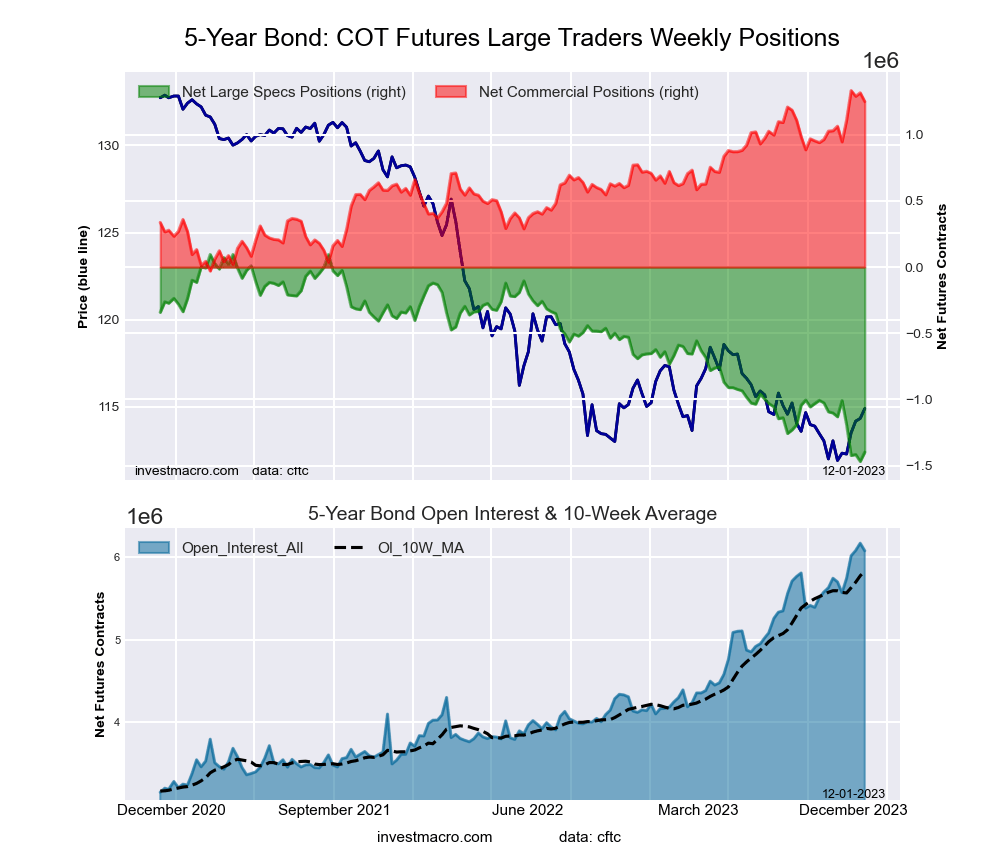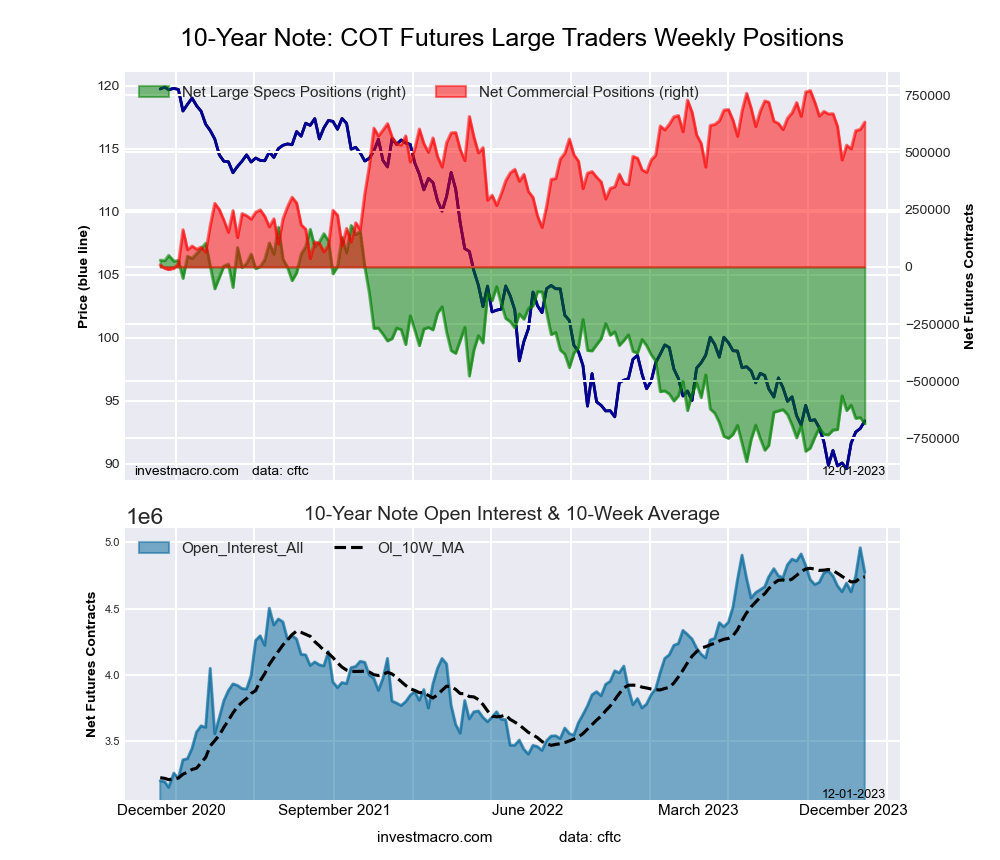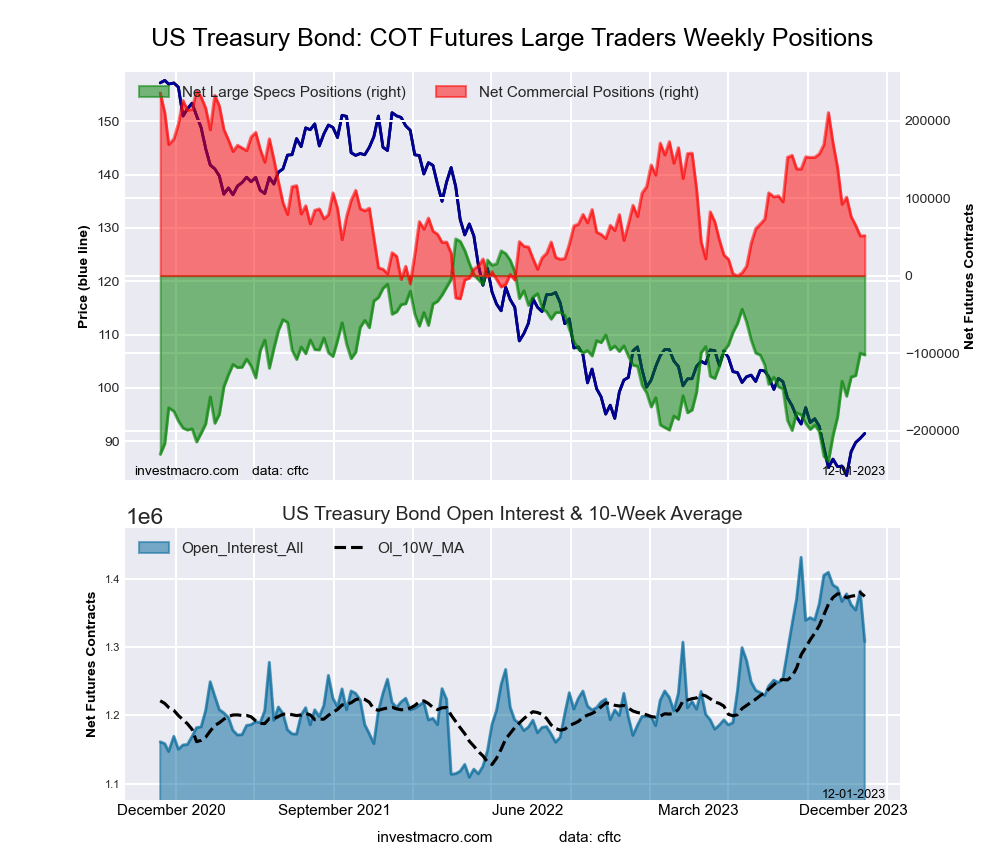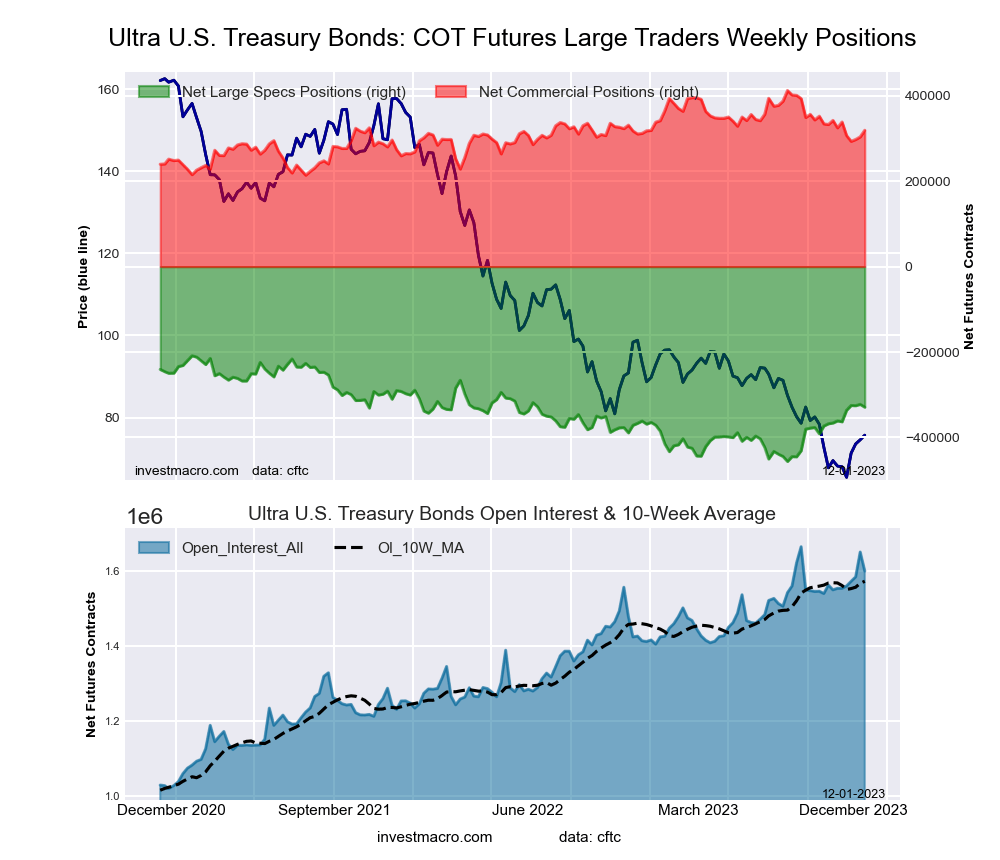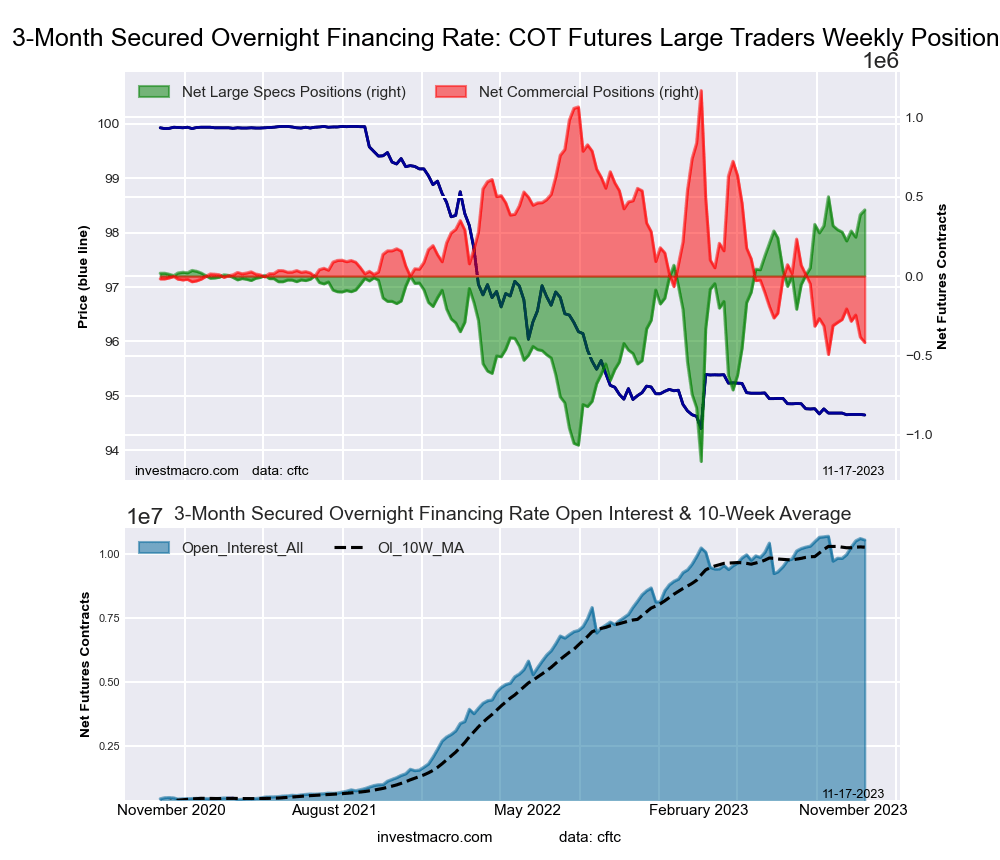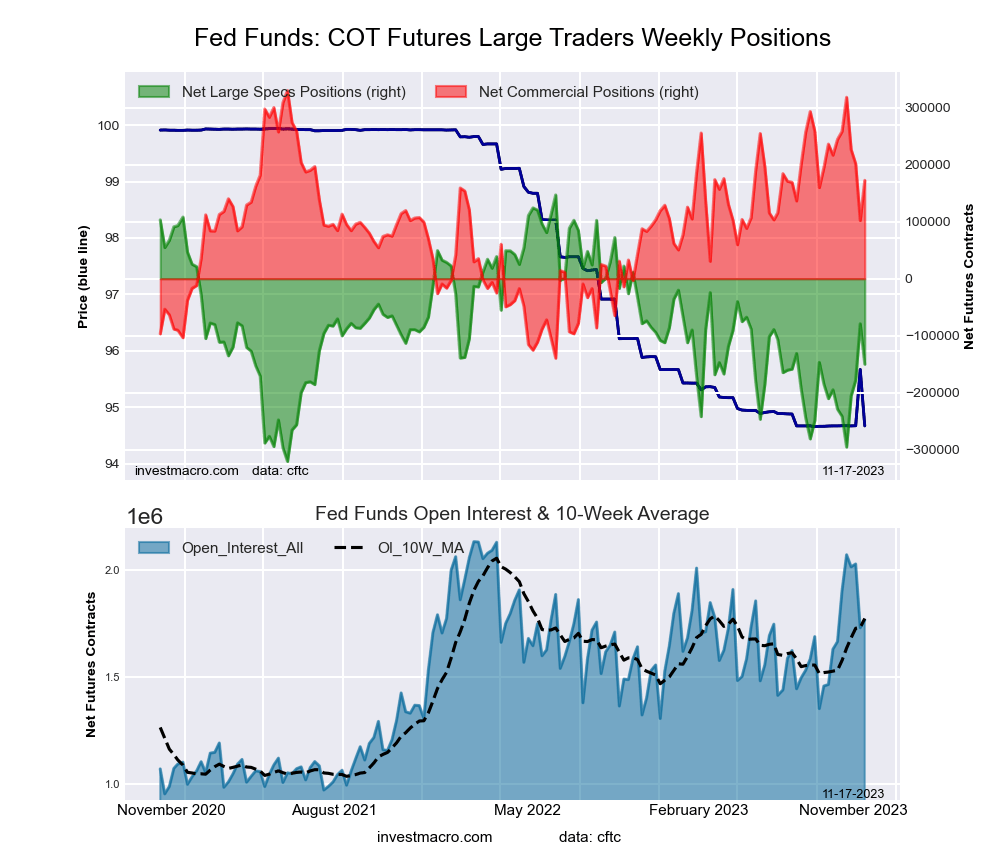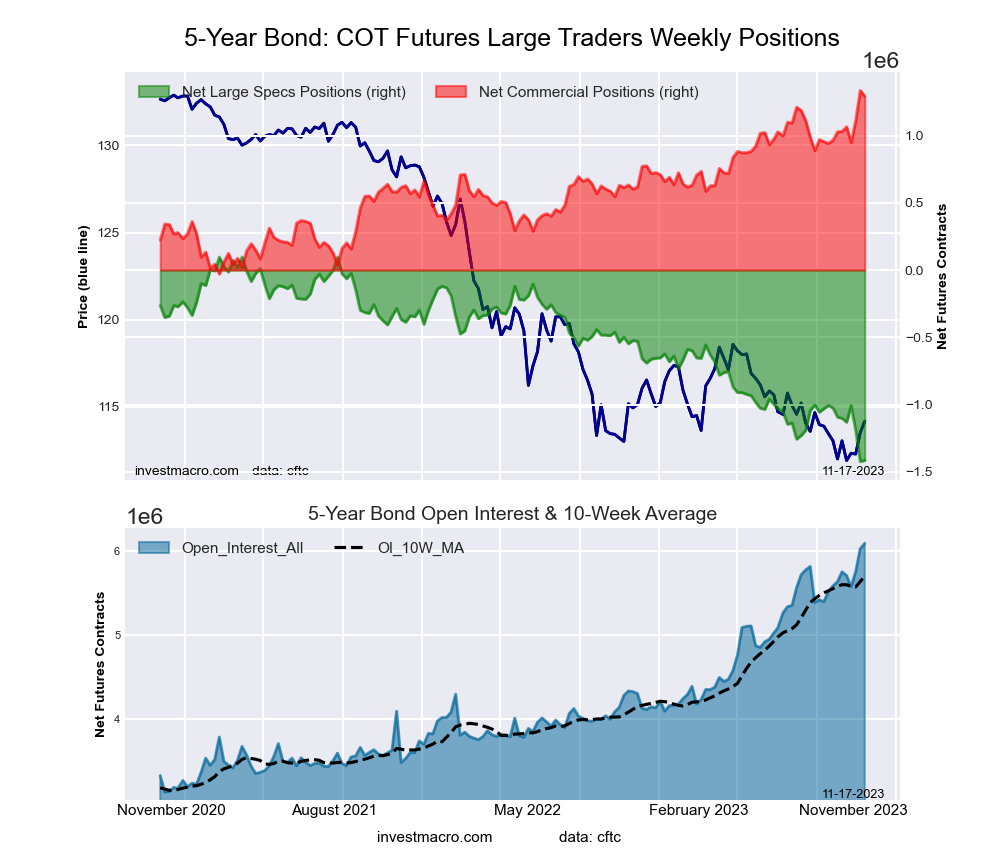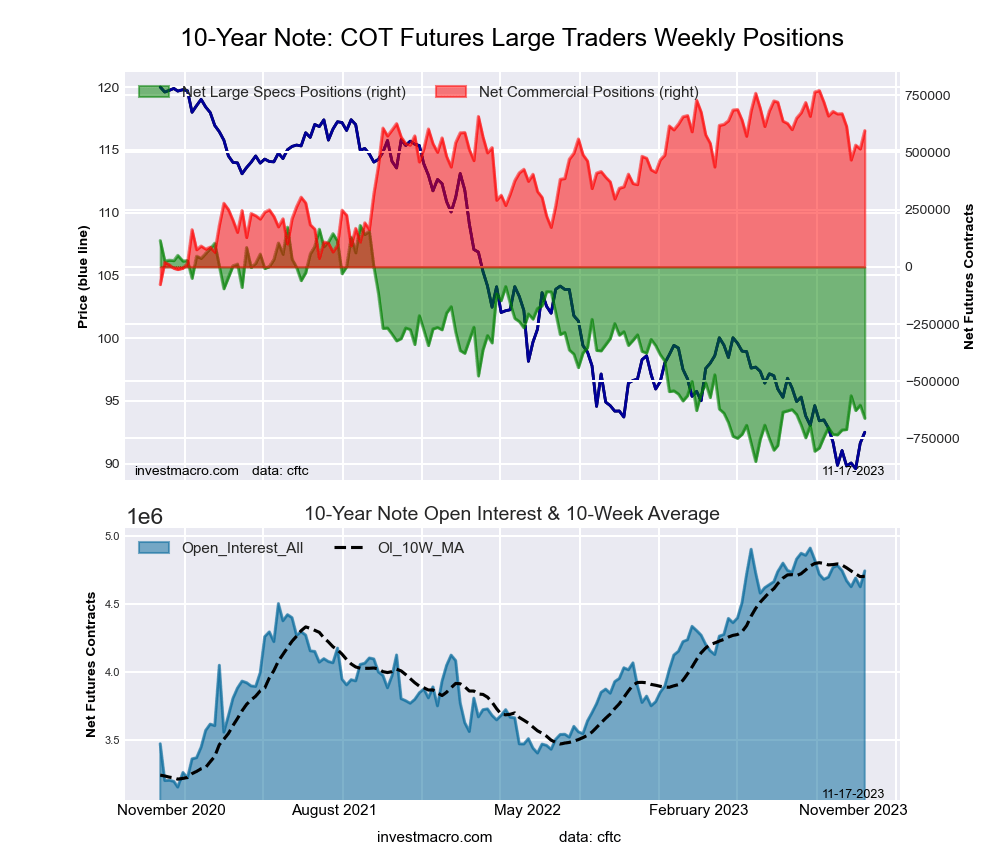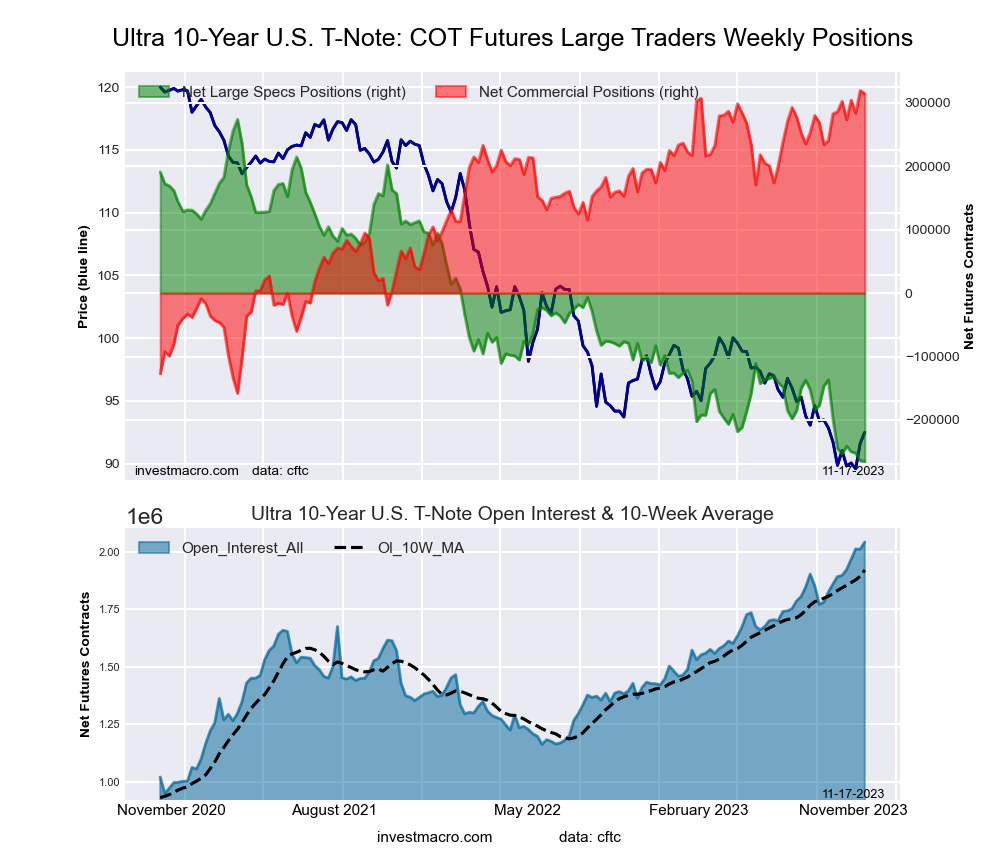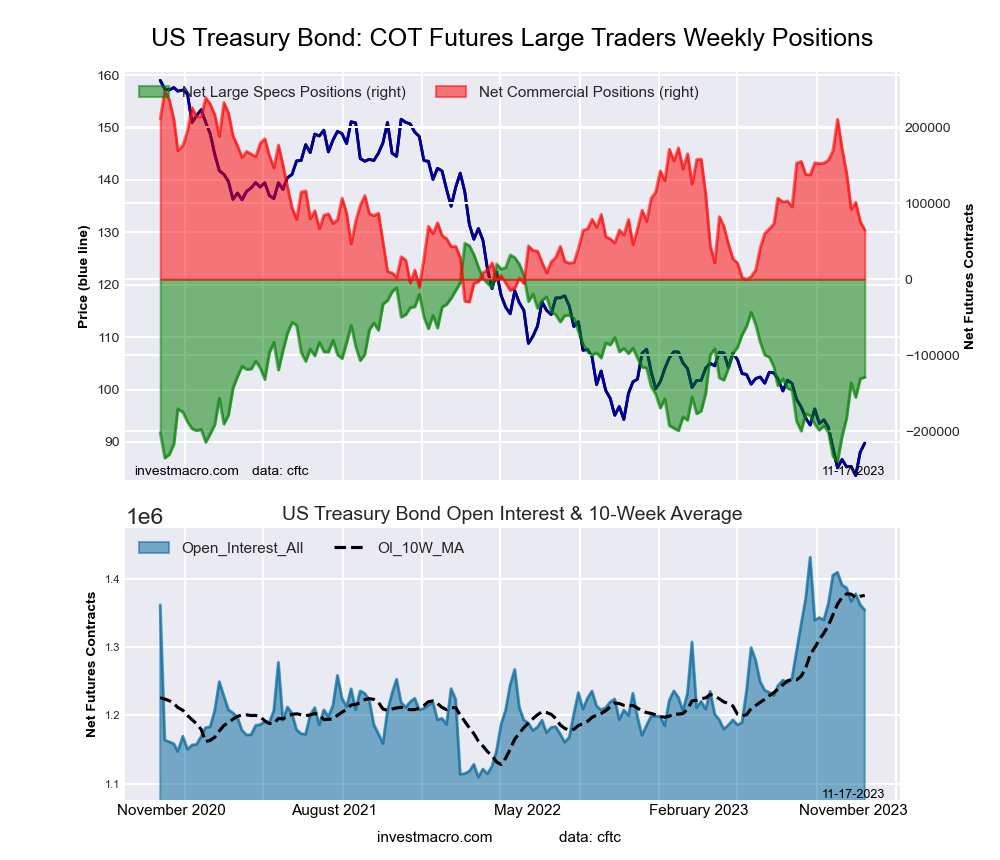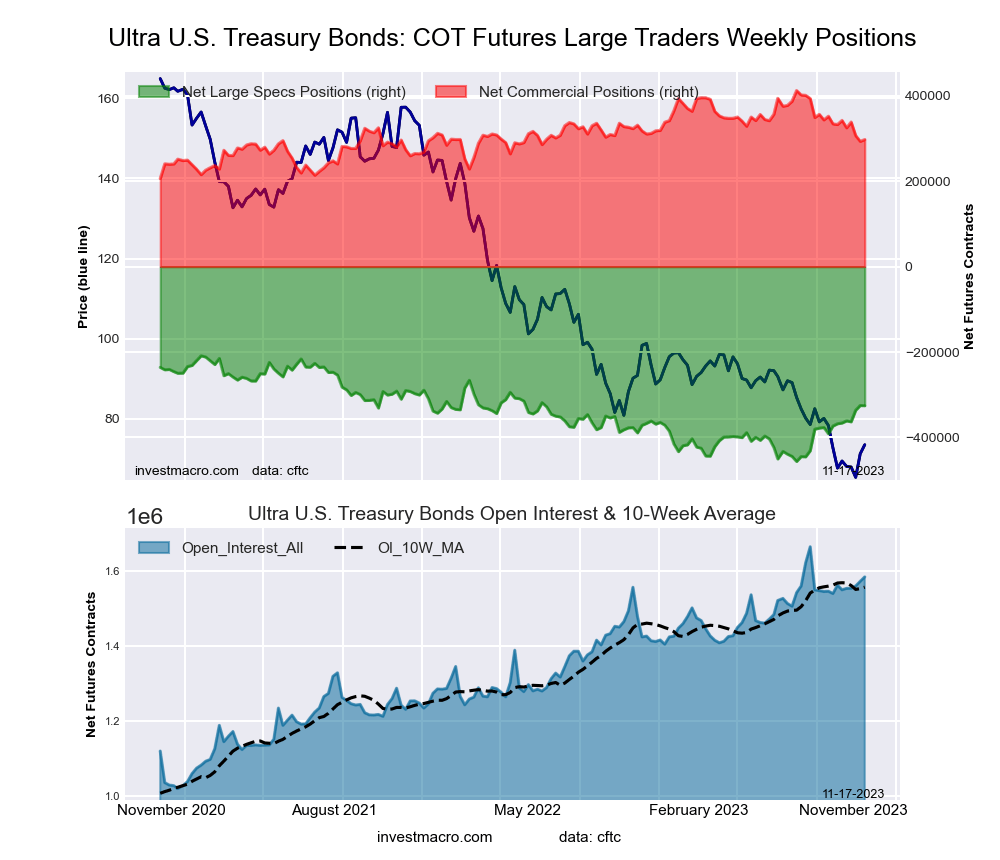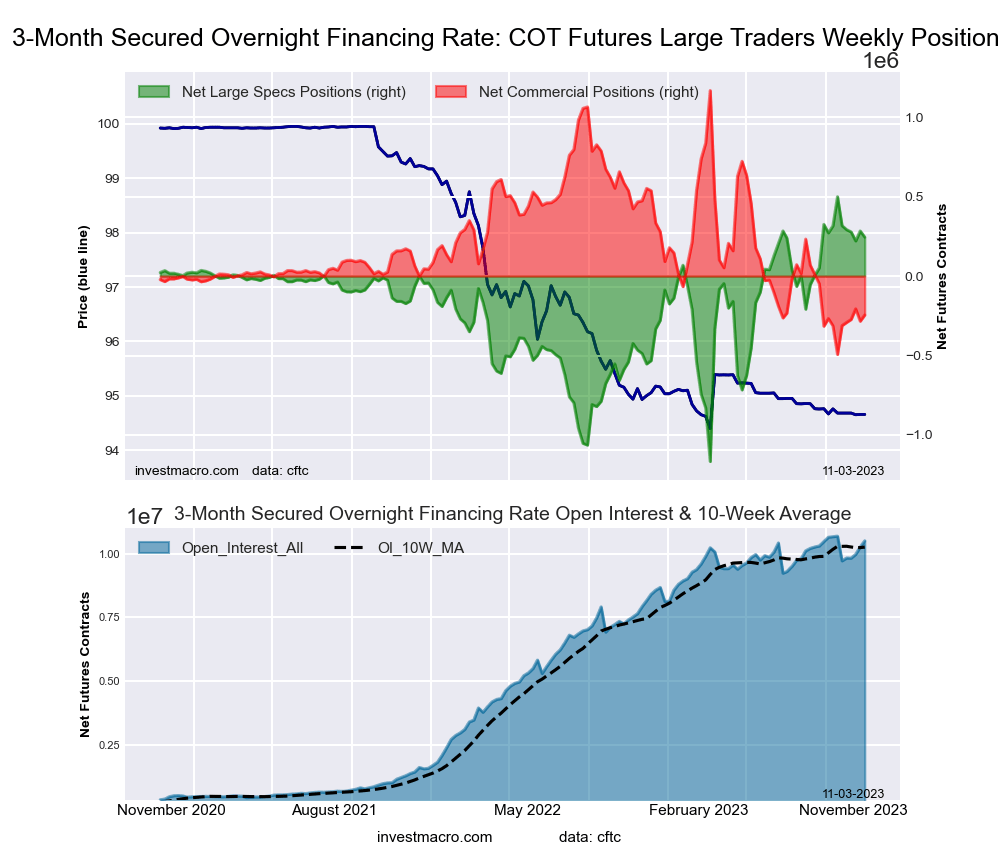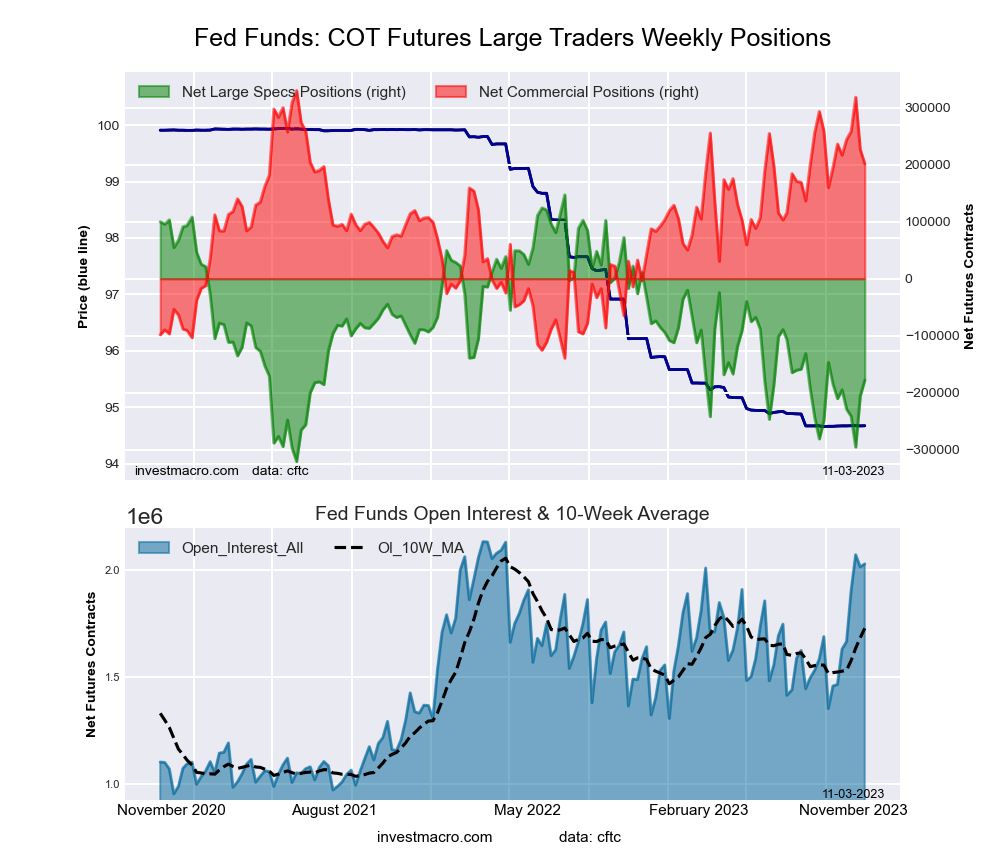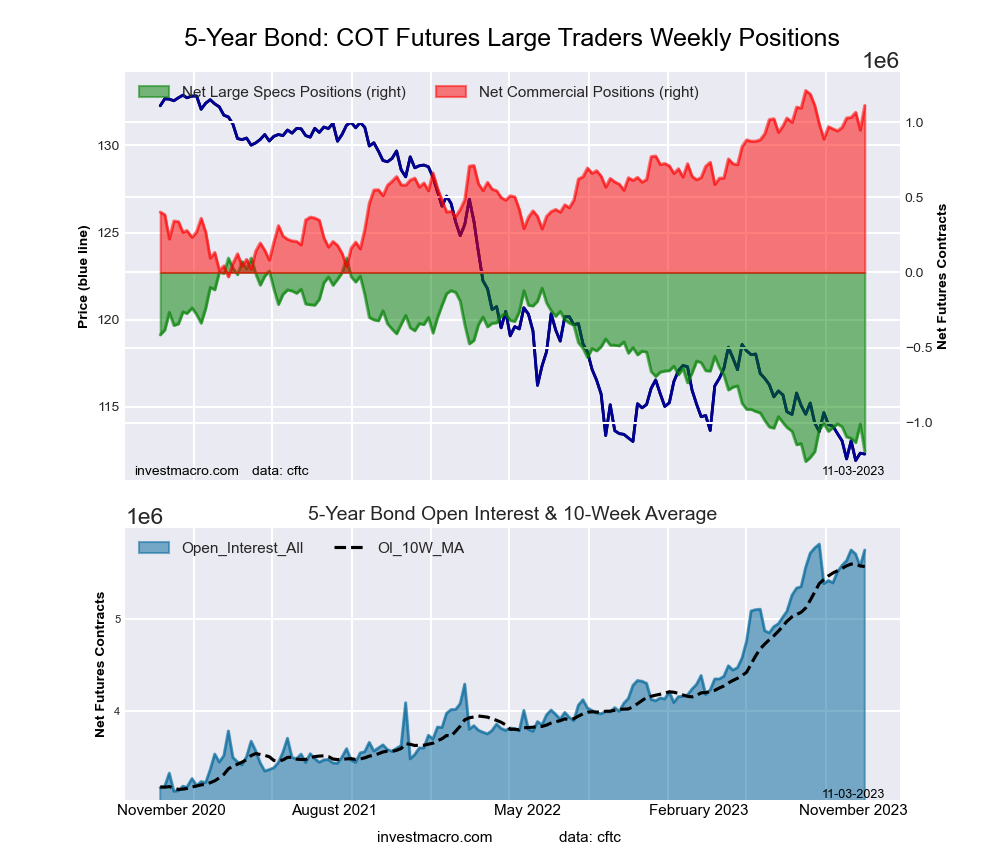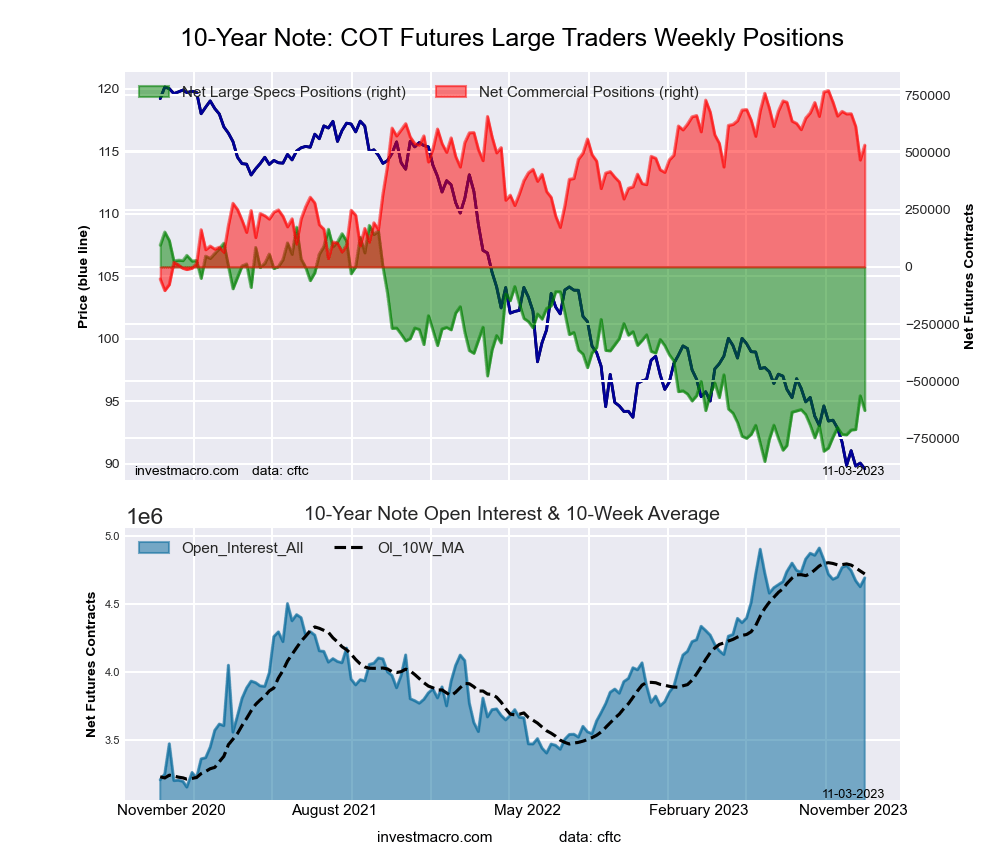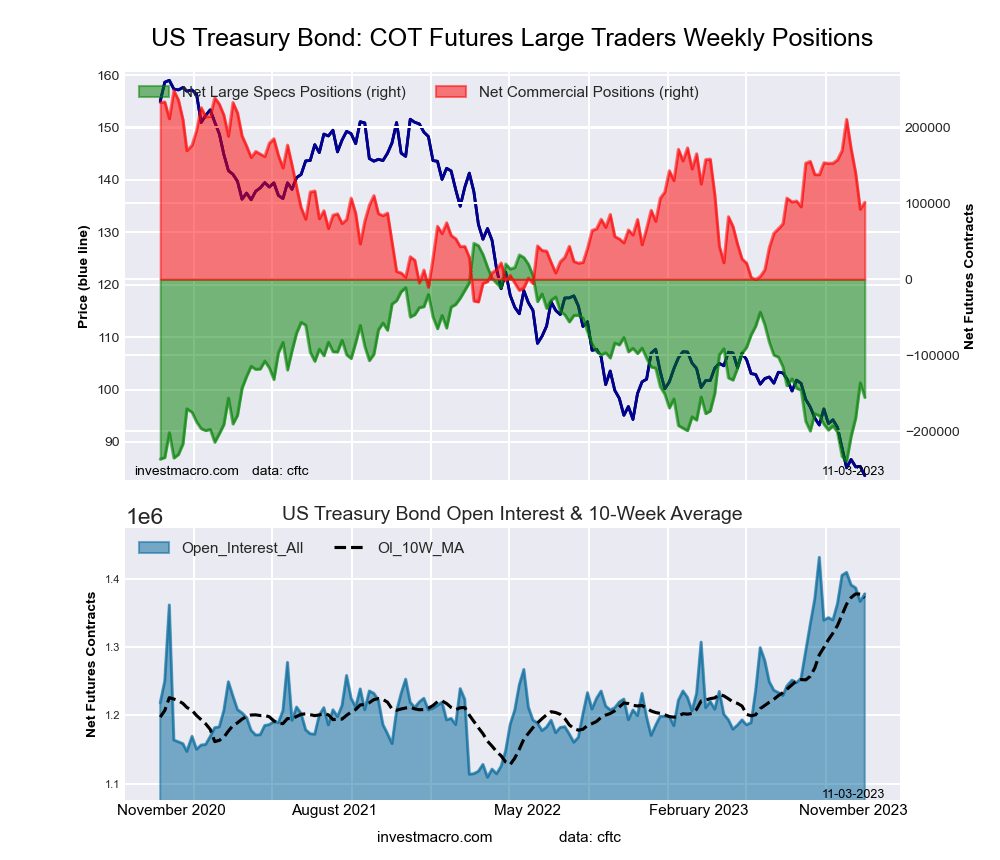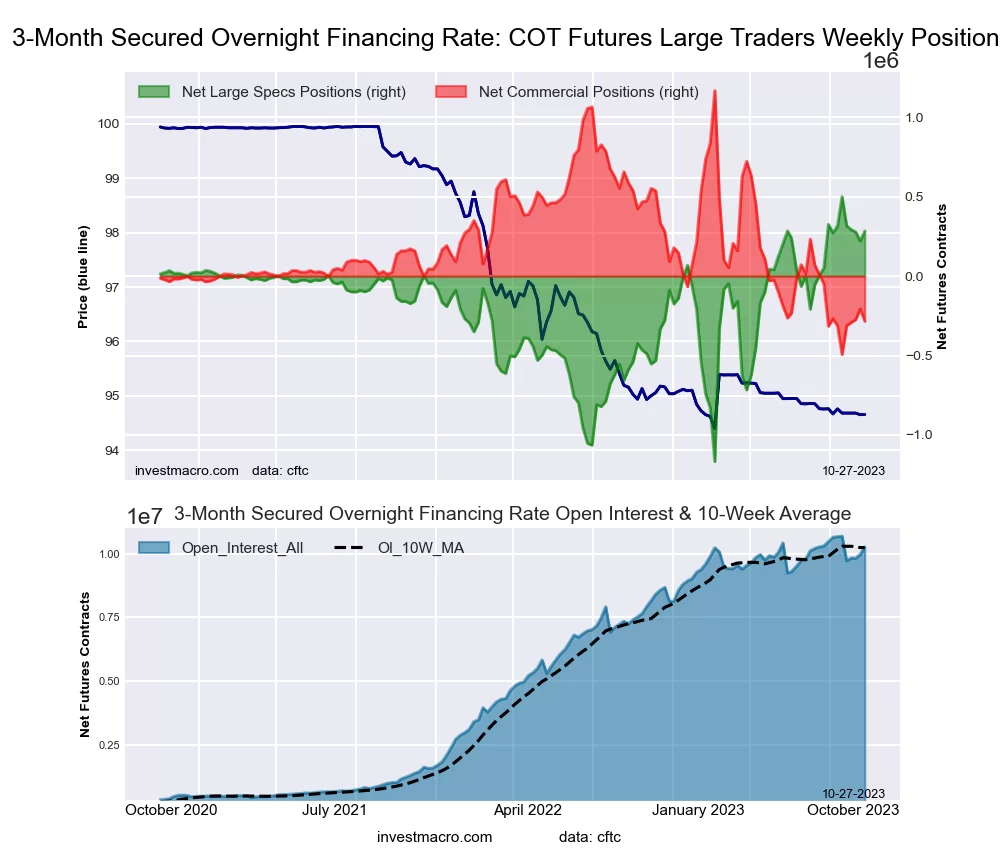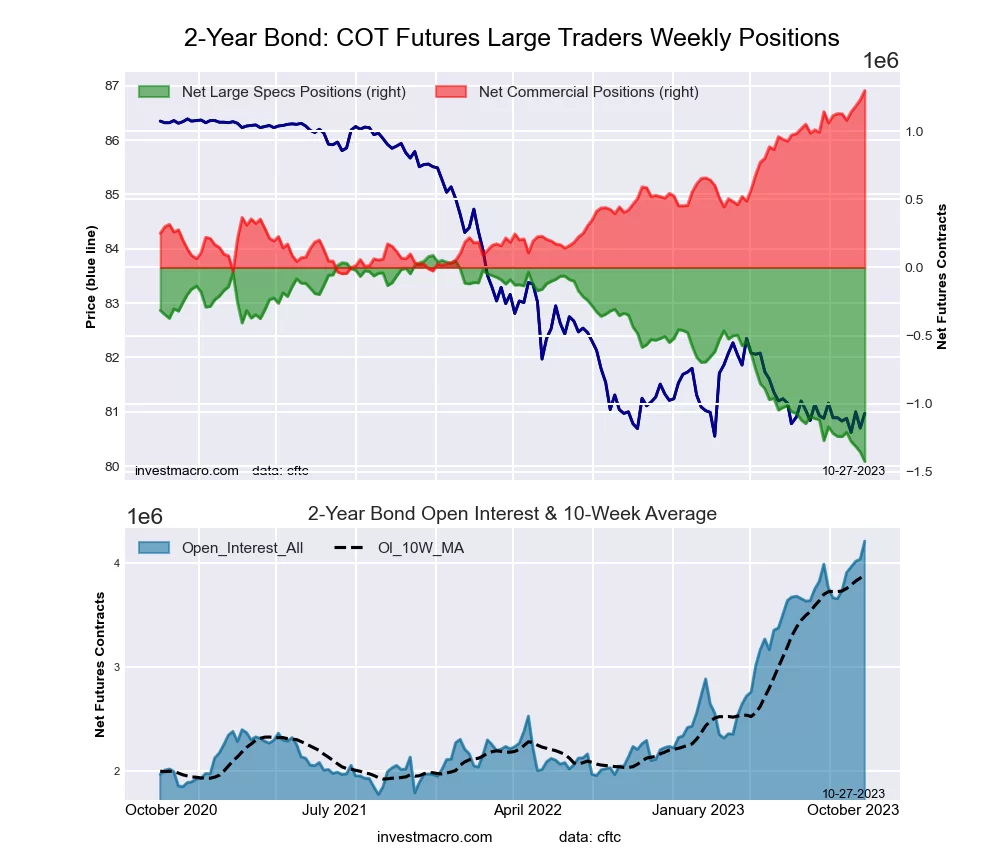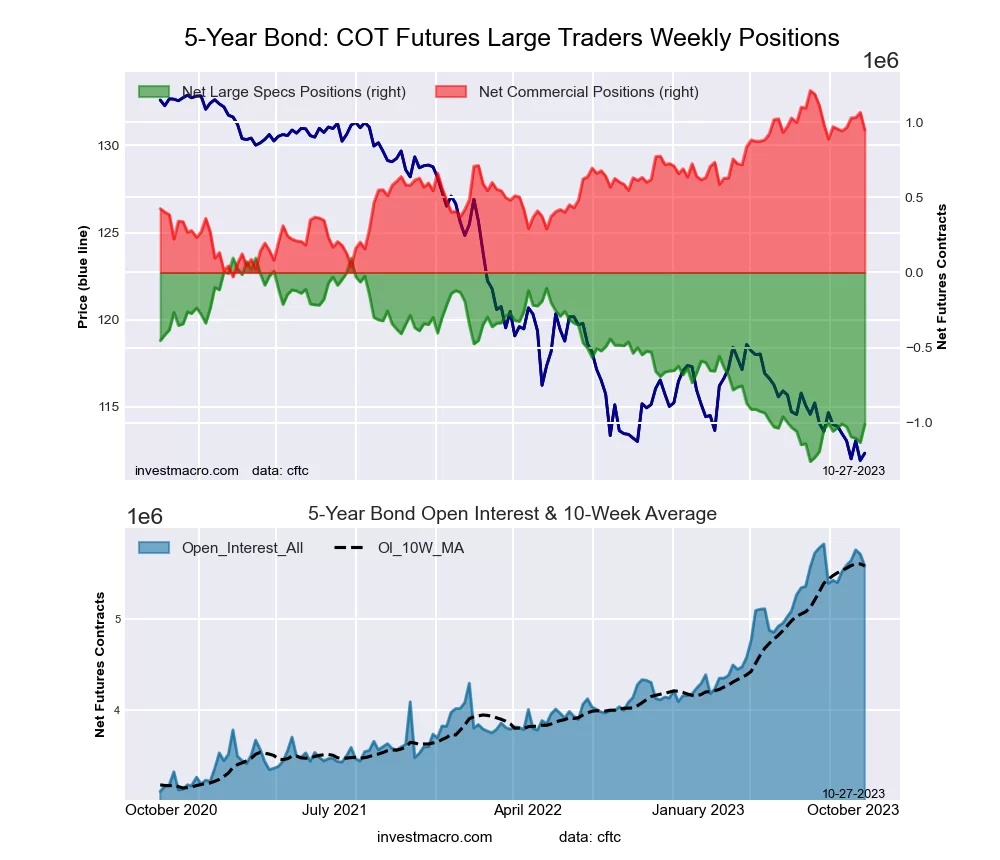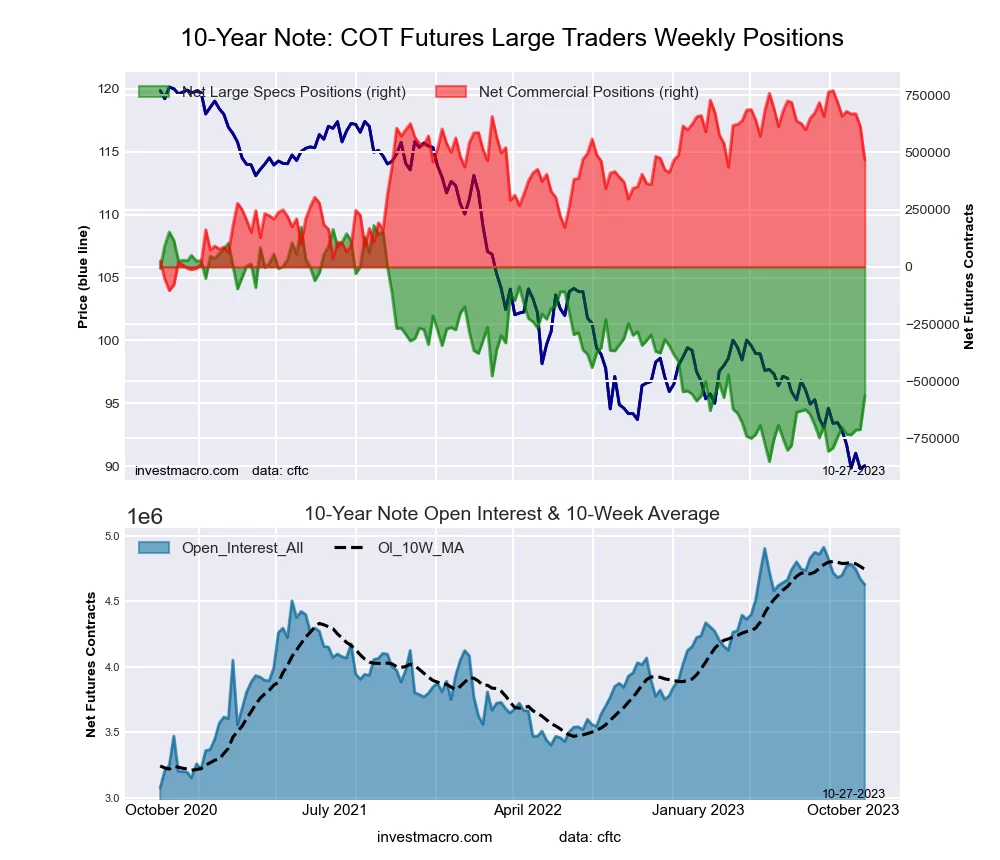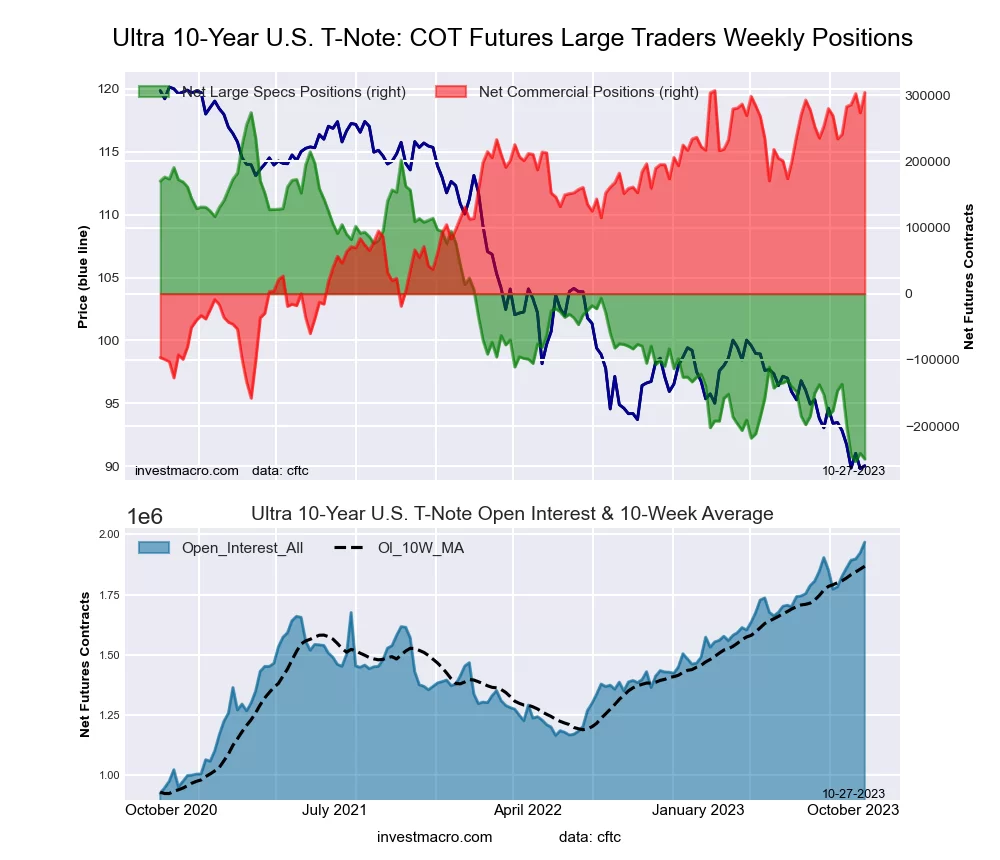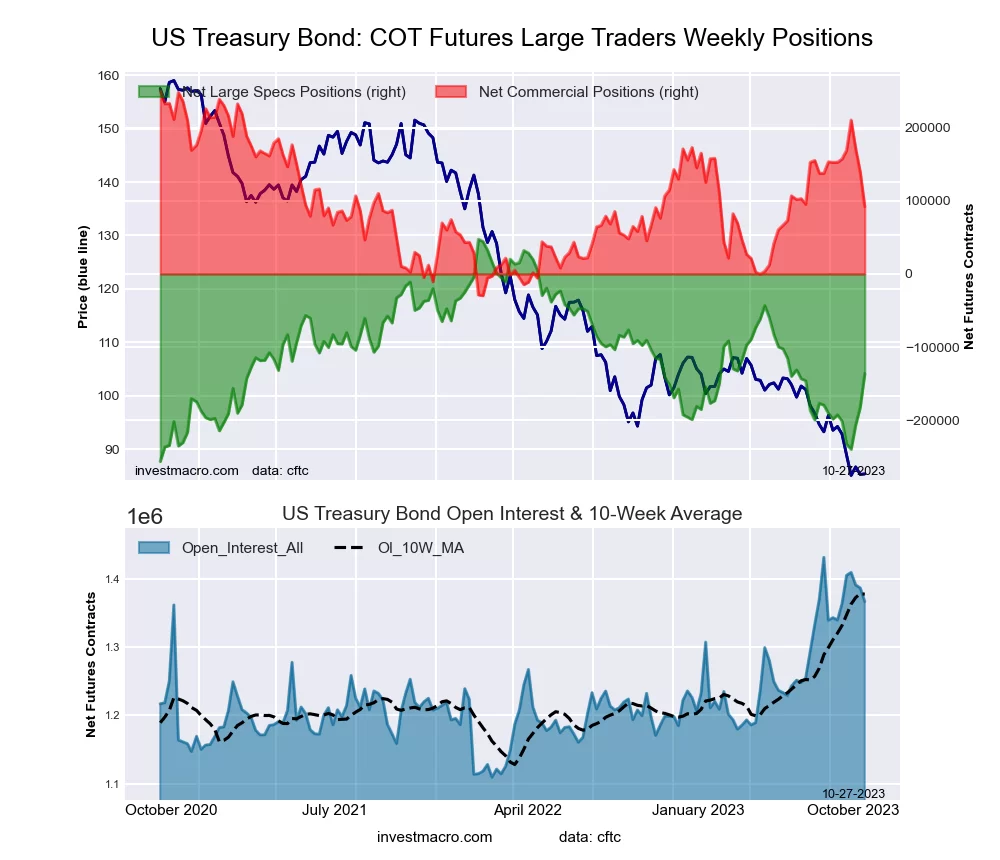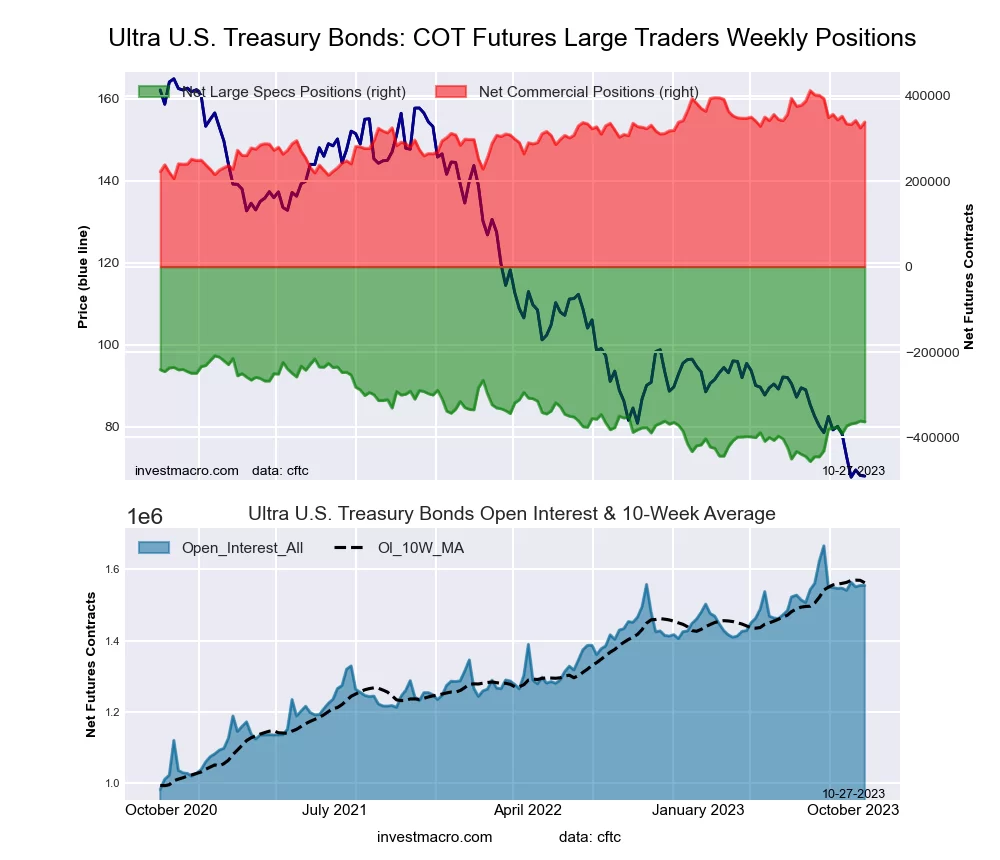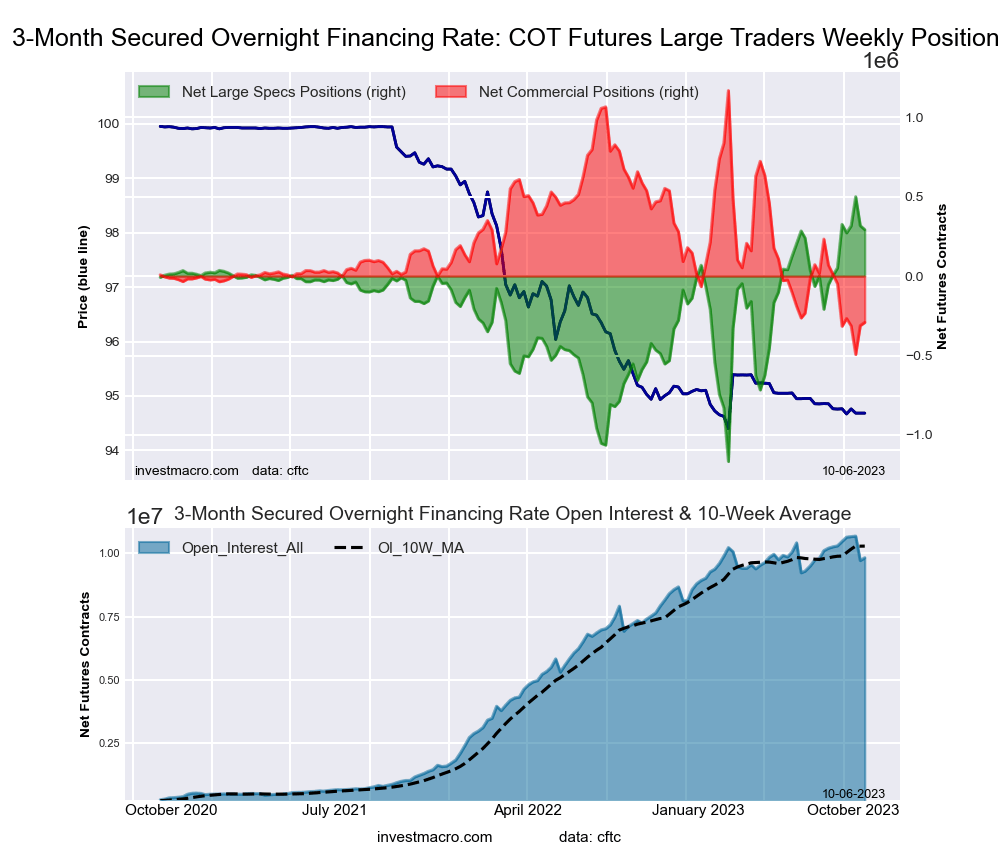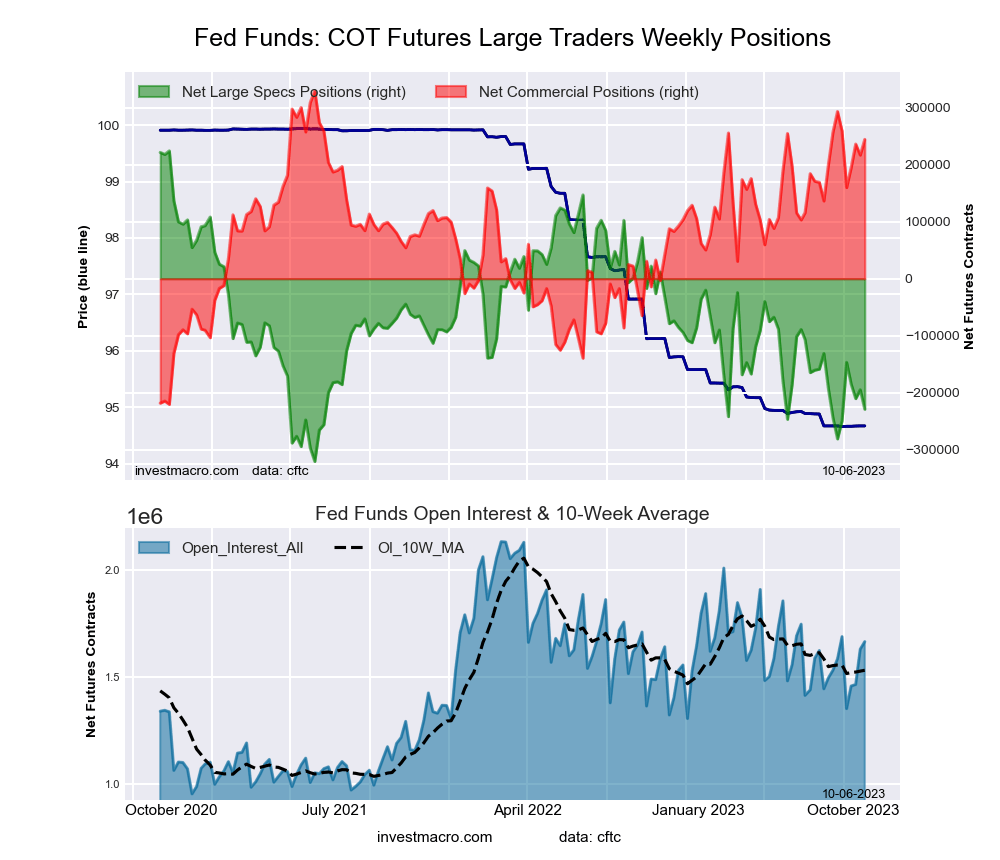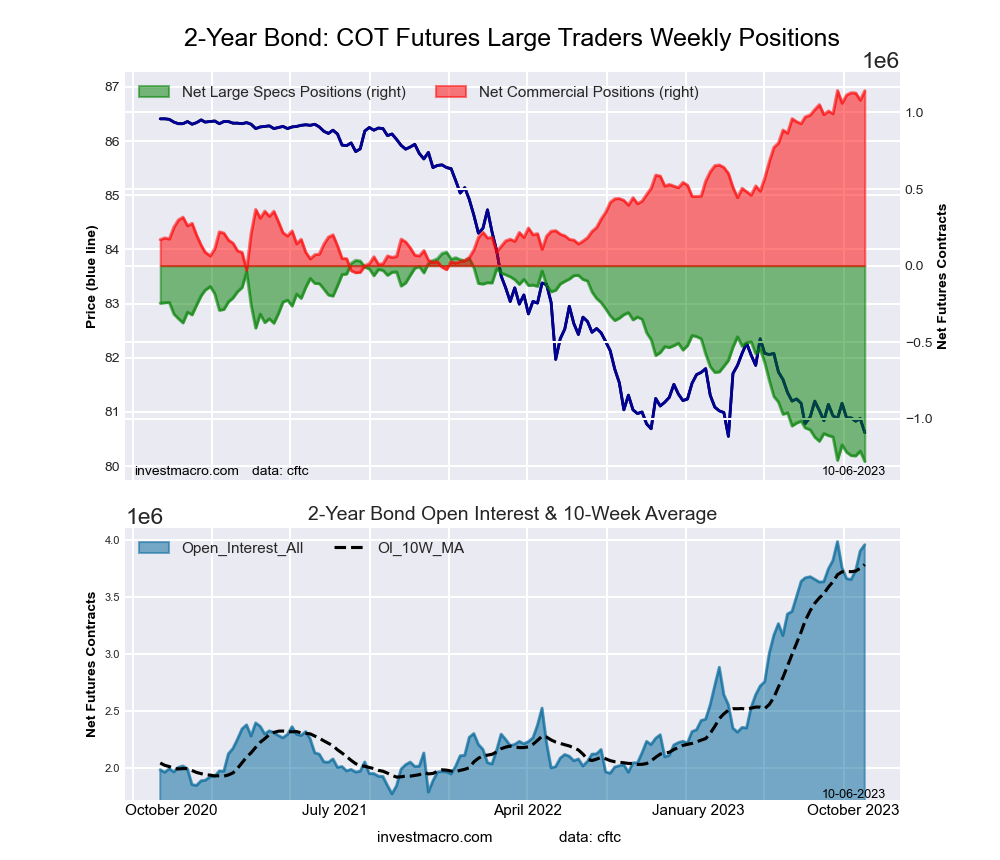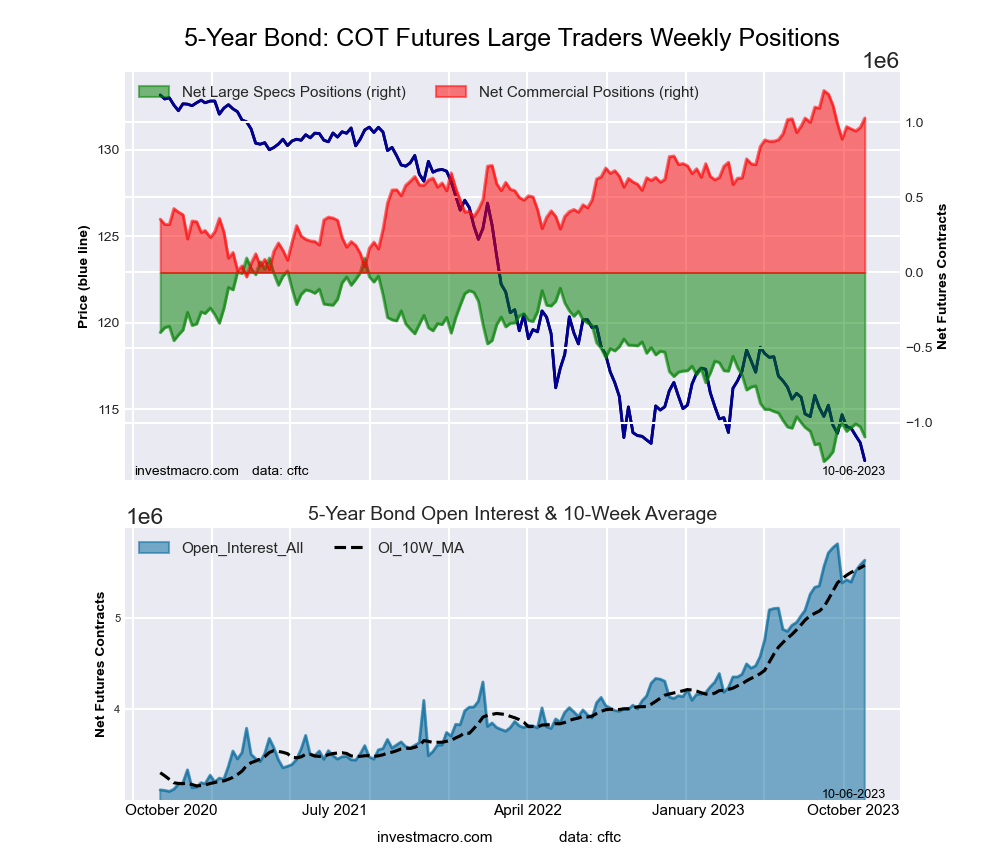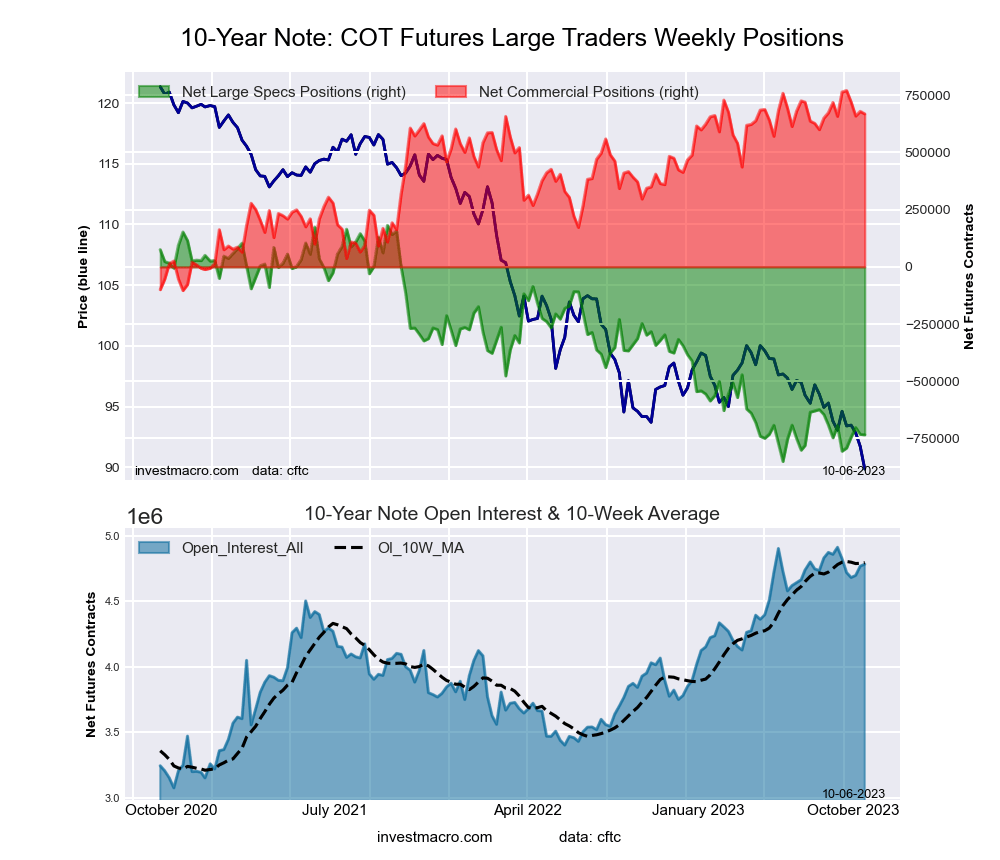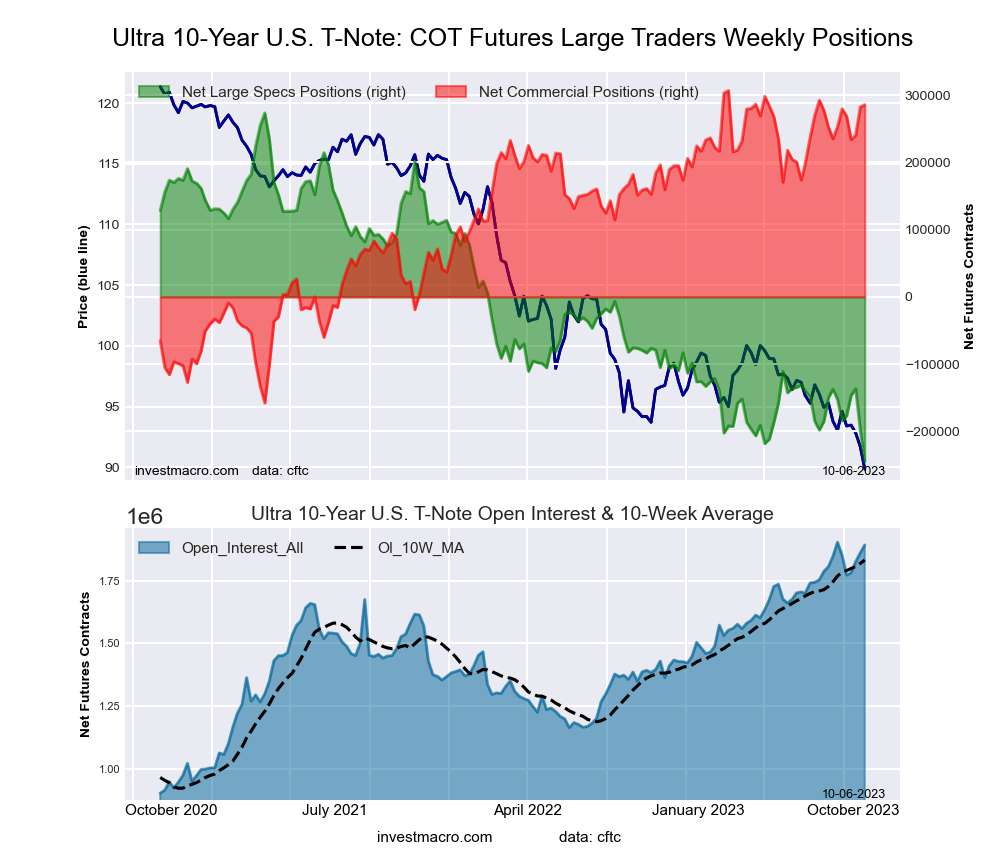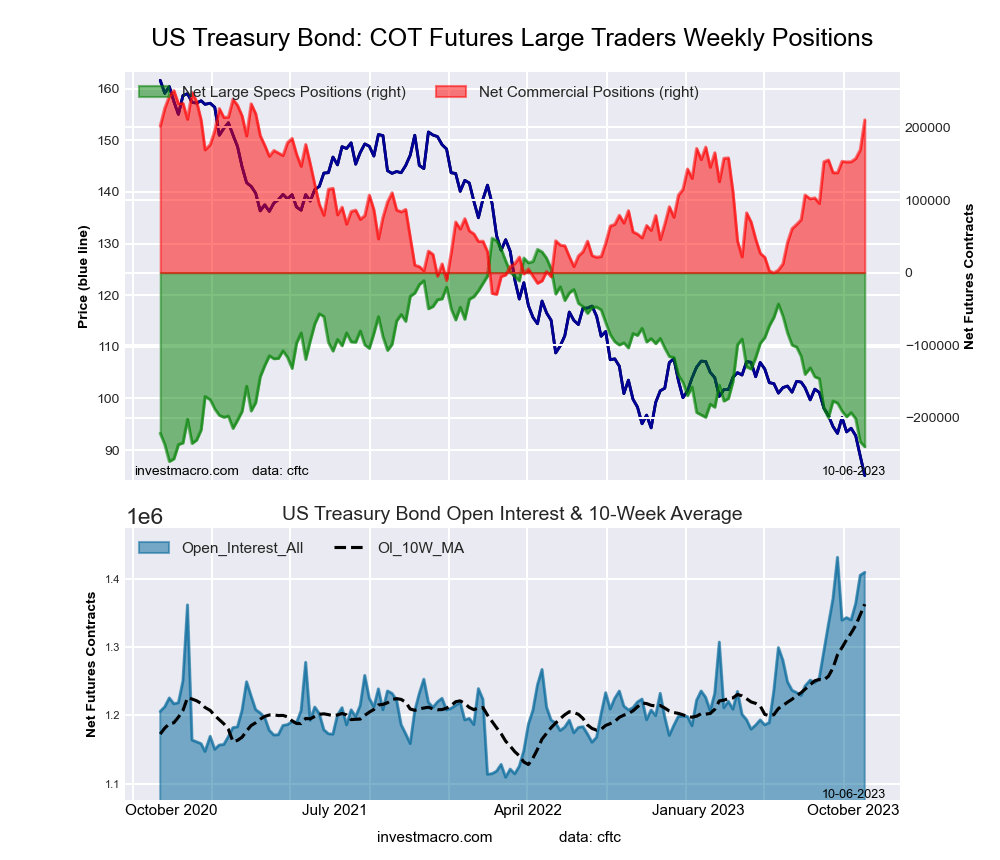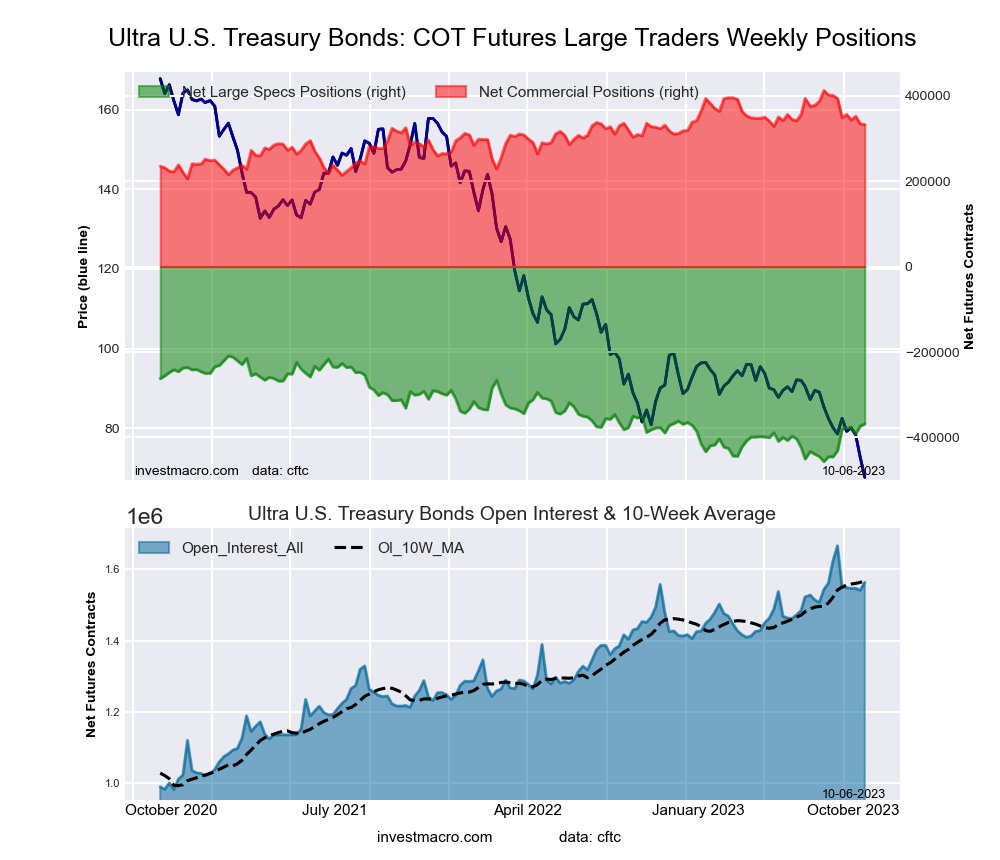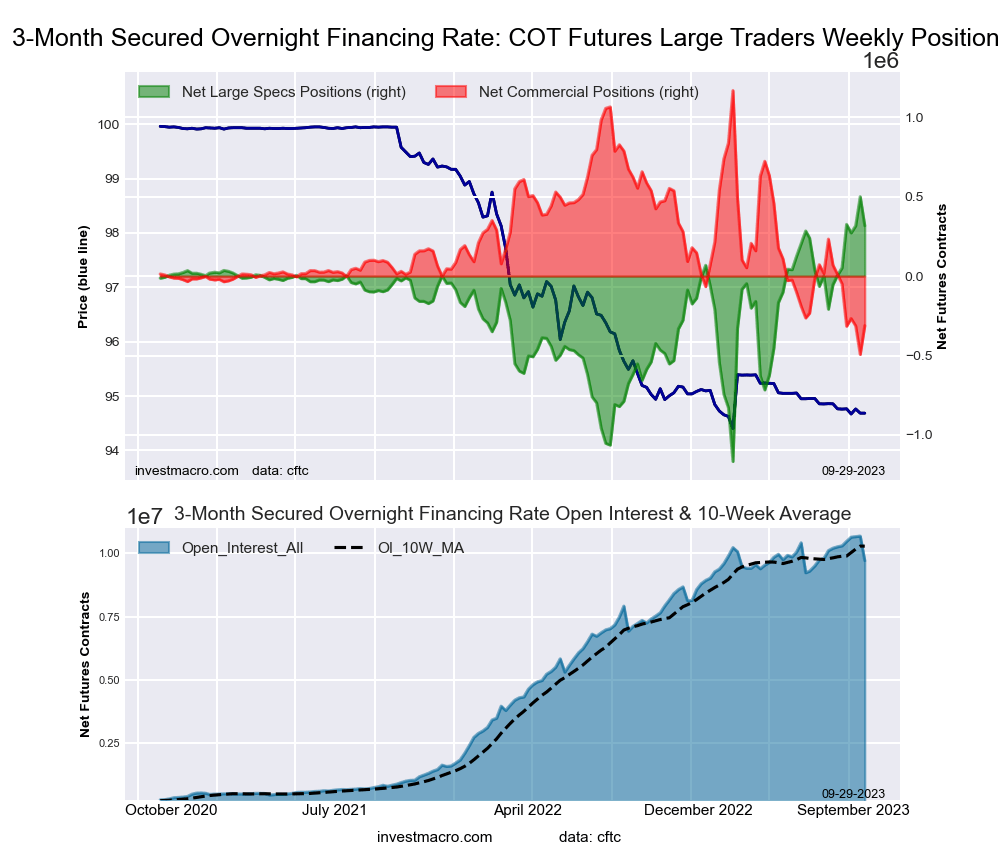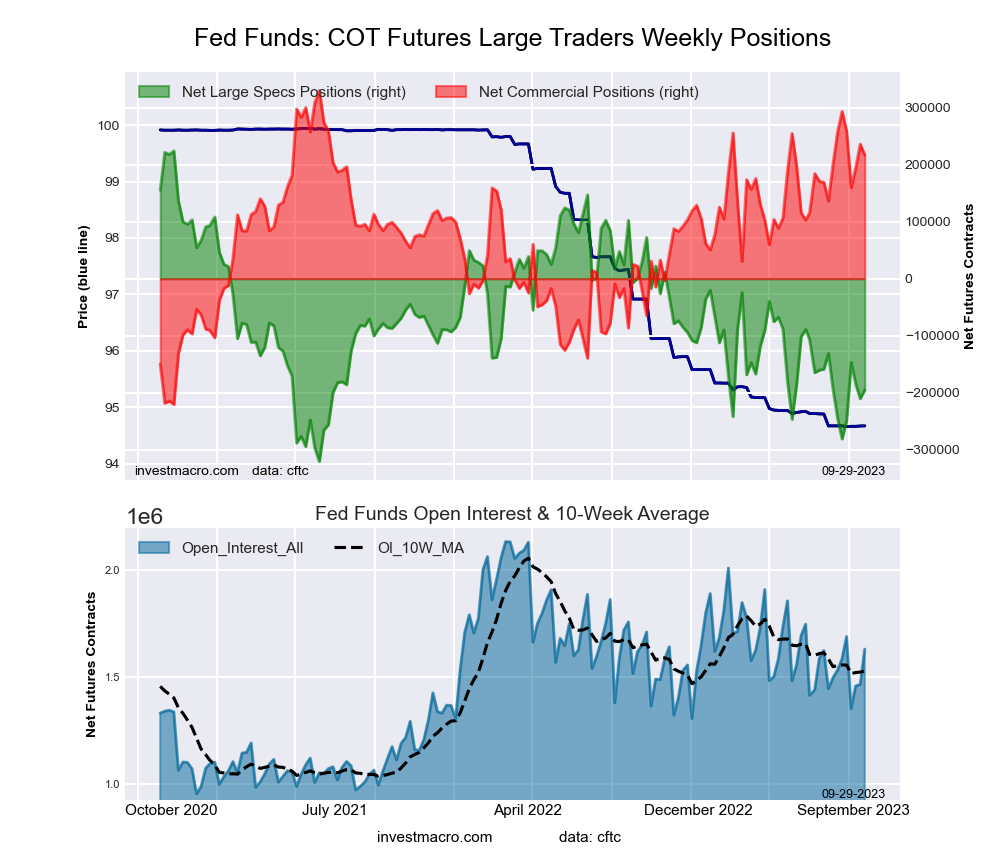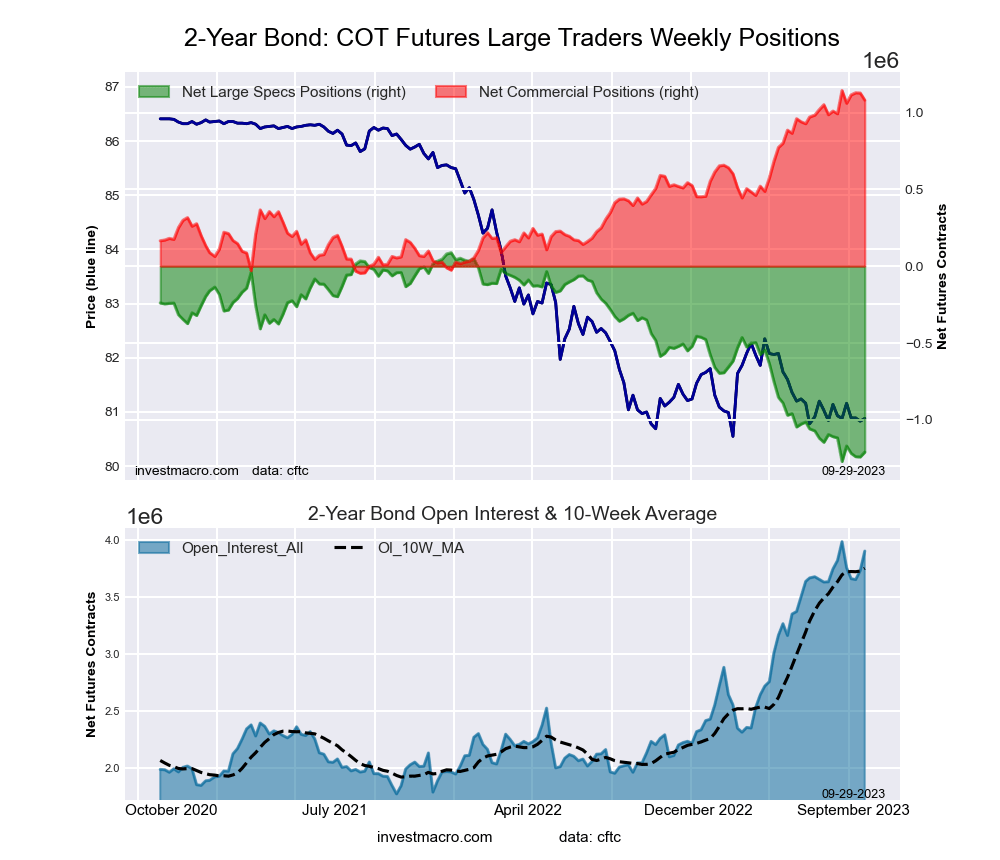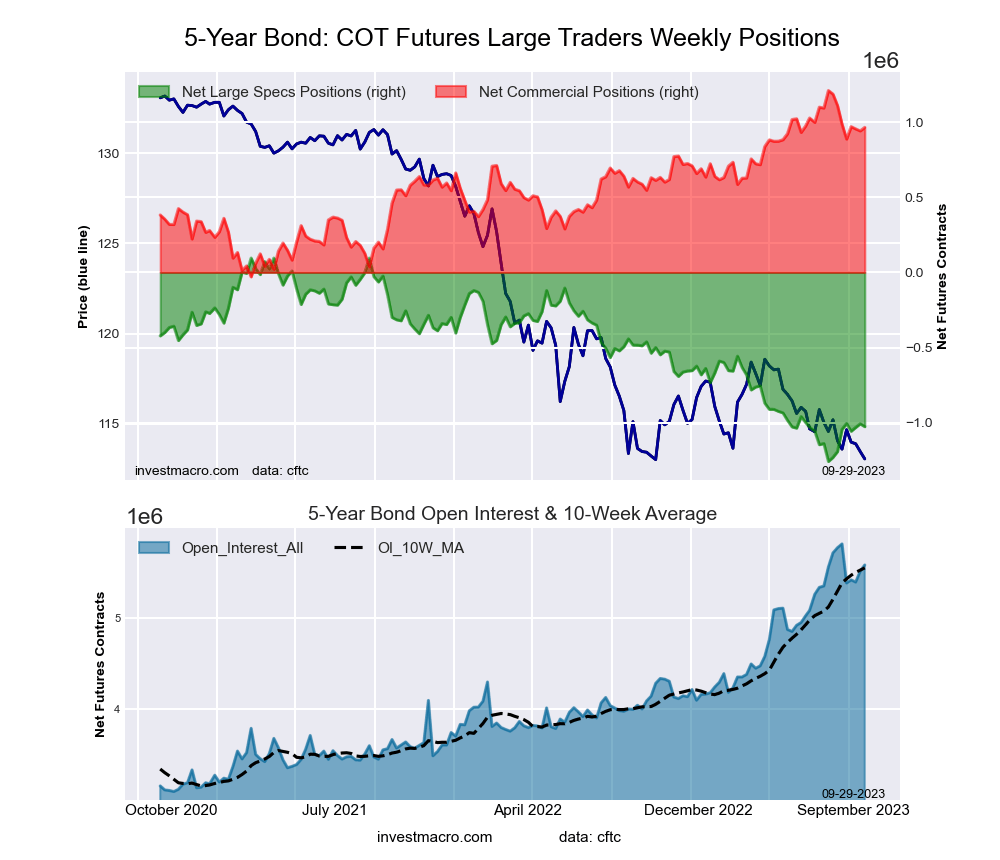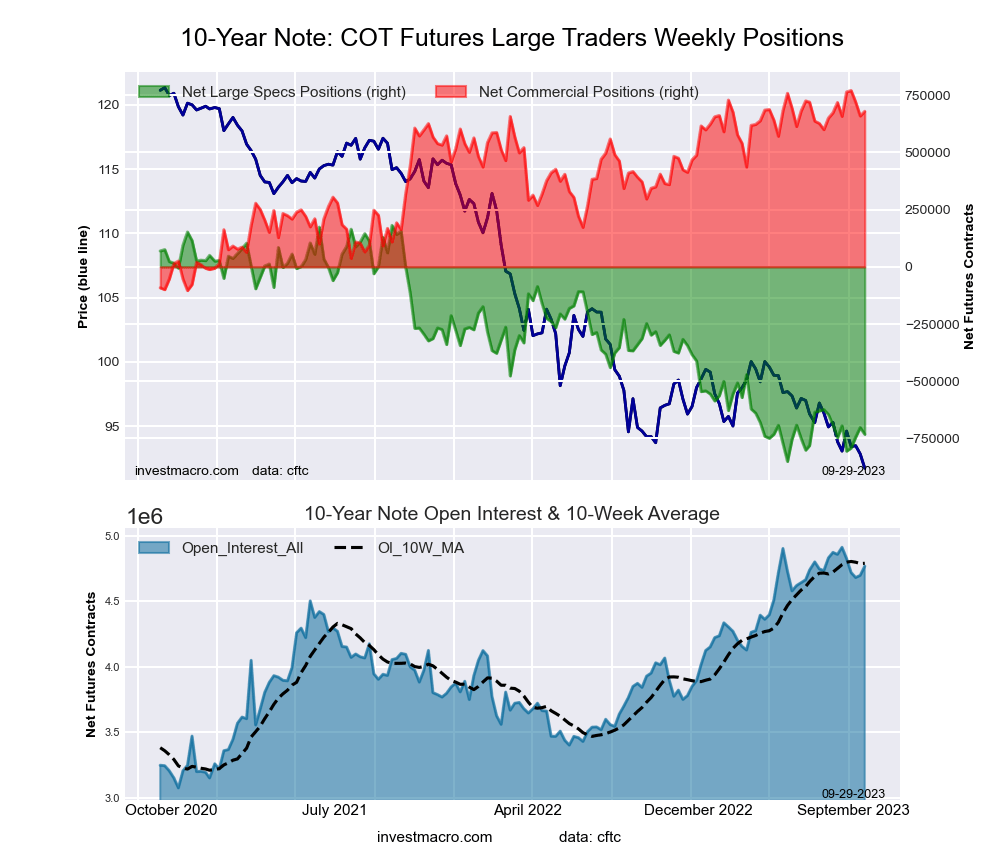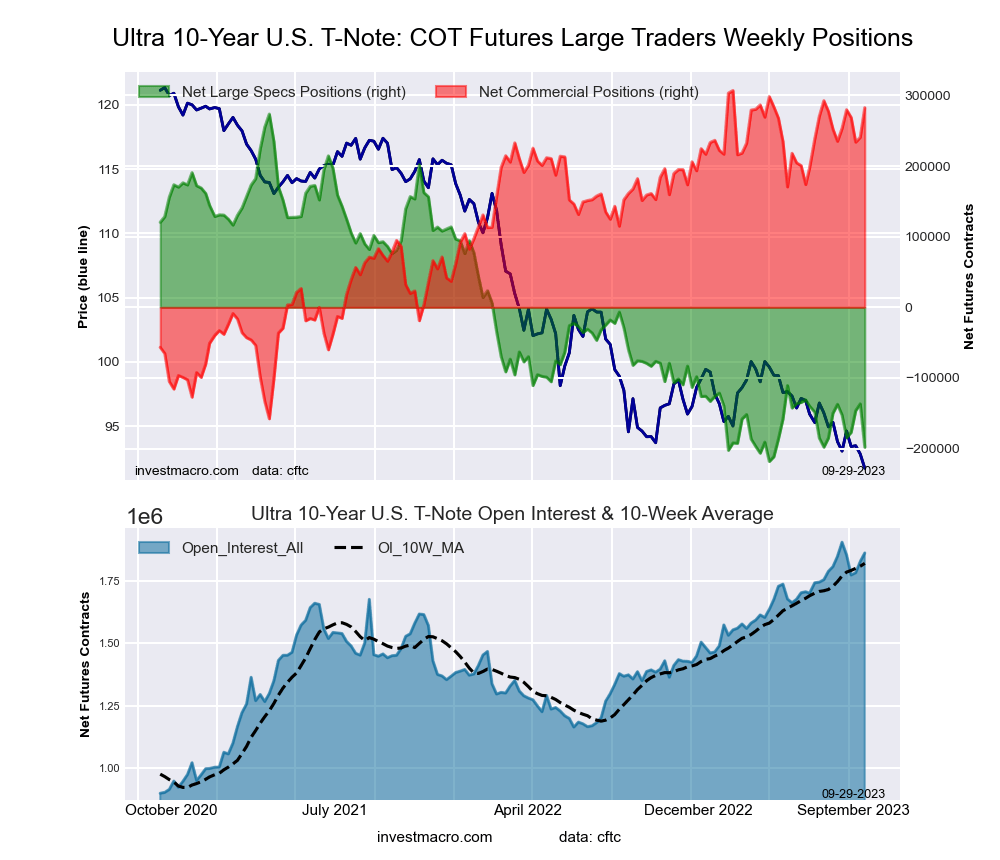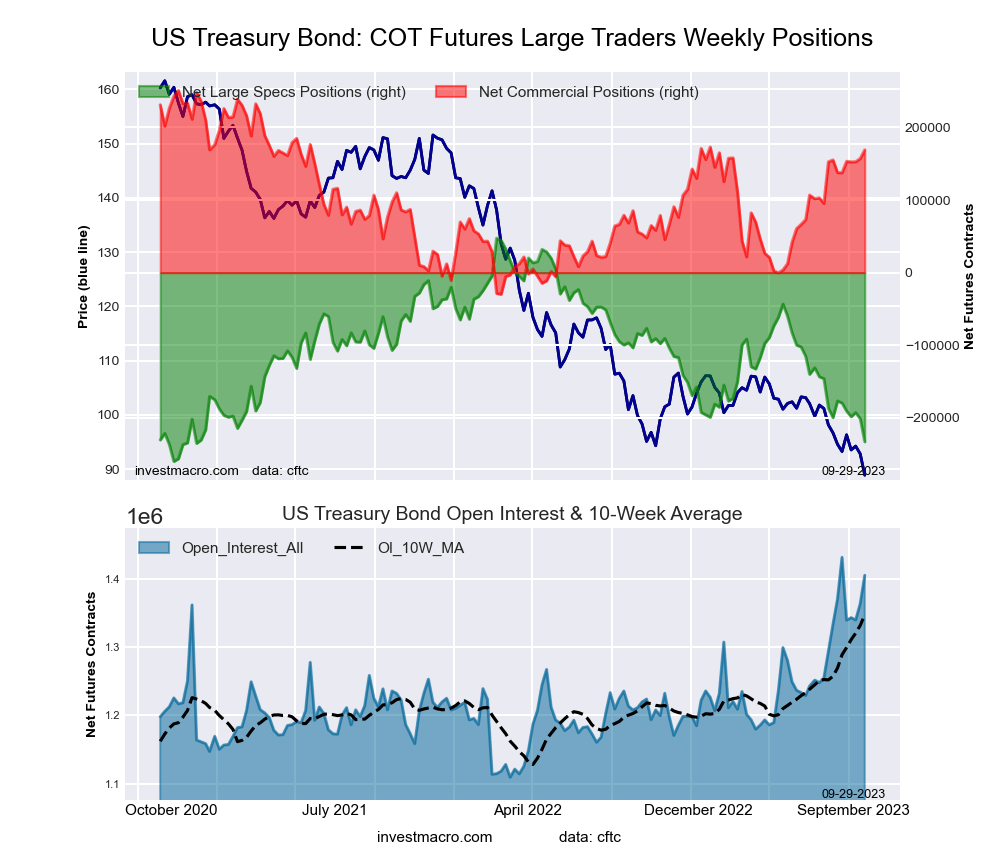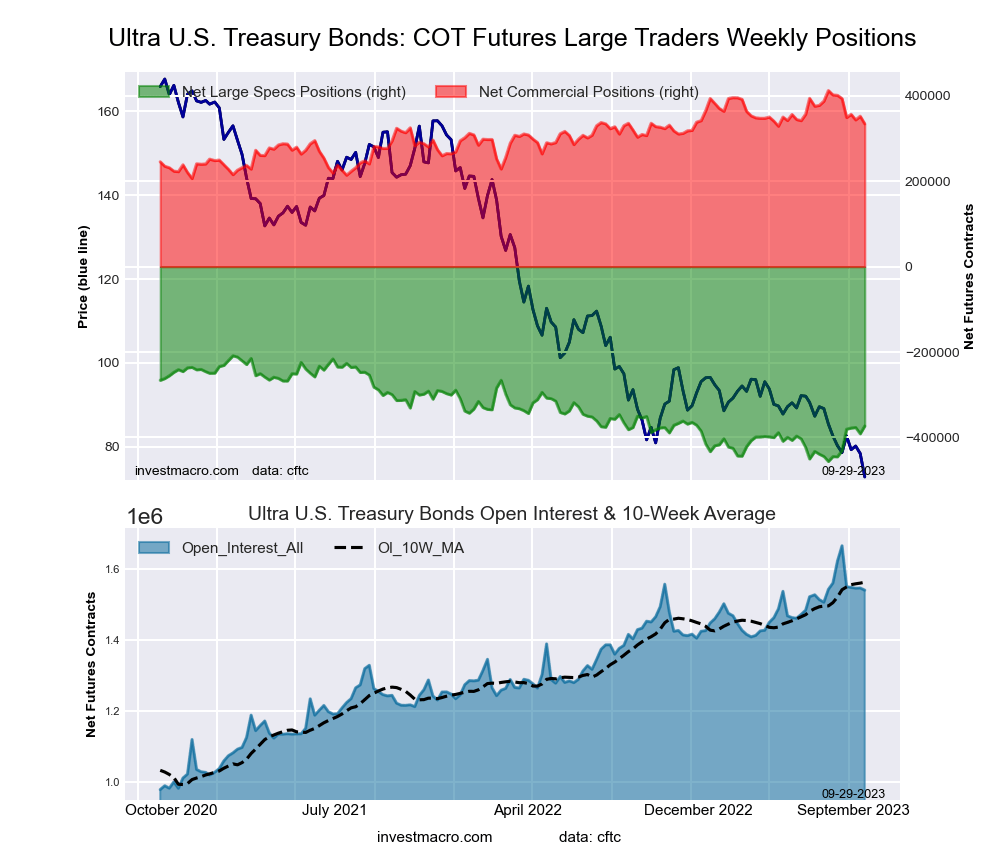By InvestMacro
Here are the latest charts and statistics for the Commitment of Traders (COT) reports data published by the Commodities Futures Trading Commission (CFTC).
The latest COT data is updated through Tuesday December 12th and shows a quick view of how large traders (for-profit speculators and commercial hedgers) were positioned in the futures markets.
Weekly Speculator Changes led by SOFR 3-Months & 2-Year Bonds
The COT bond market speculator bets were higher this week as five out of the eight bond markets we cover had higher positioning while the other three markets had lower speculator contracts.
Leading the gains for the bond markets was the SOFR 3-Months (206,446 contracts) with the 2-Year Bonds (116,542 contracts), the 5-Year Bonds (89,307 contracts), the 10-Year Bonds (79,525 contracts) and the Ultra Treasury Bonds (23,682 contracts) recording strong positive weeks.
The bond markets with declines in speculator bets for the week were the Ultra 10-Year Bonds (-8,621 contracts), the US Treasury Bonds (-6,180 contracts) and the Fed Funds (-6,043 contracts).
| Dec-12-2023 | OI | OI-Index | Spec-Net | Spec-Index | Com-Net | COM-Index | Smalls-Net | Smalls-Index |
|---|---|---|---|---|---|---|---|---|
| SOFR-3-Months | 11,214,870 | 100 | 718,226 | 100 | -715,081 | 0 | -3,145 | 86 |
| FedFunds | 1,493,915 | 45 | -159,197 | 35 | 172,723 | 66 | -13,526 | 64 |
| 2-Year | 3,950,417 | 89 | -1,359,474 | 7 | 1,223,113 | 92 | 136,361 | 96 |
| Long T-Bond | 1,308,164 | 62 | -136,259 | 36 | 100,575 | 49 | 35,684 | 74 |
| 10-Year | 4,475,716 | 73 | -556,931 | 28 | 520,684 | 68 | 36,247 | 81 |
| 5-Year | 5,737,034 | 85 | -1,340,120 | 8 | 1,206,871 | 91 | 133,249 | 96 |
Strength Scores led by SOFR 3-Months & Ultra Treasury Bonds
COT Strength Scores (a normalized measure of Speculator positions over a 3-Year range, from 0 to 100 where above 80 is Extreme-Bullish and below 20 is Extreme-Bearish) showed that the SOFR 3-Months (100 percent) and the Ultra Treasury Bonds (66 percent) lead the bond markets this week.
On the downside, the Ultra 10-Year Bonds (0 percent), the 2-Year Bonds (7 percent) and the 5-Year Bonds (8 percent) come in at the lowest strength level currently and are in Extreme-Bearish territory (below 20 percent).
Strength Statistics:
Fed Funds (34.5 percent) vs Fed Funds previous week (35.8 percent)
2-Year Bond (7.5 percent) vs 2-Year Bond previous week (0.0 percent)
5-Year Bond (8.2 percent) vs 5-Year Bond previous week (2.5 percent)
10-Year Bond (28.4 percent) vs 10-Year Bond previous week (20.7 percent)
Ultra 10-Year Bond (0.0 percent) vs Ultra 10-Year Bond previous week (1.6 percent)
US Treasury Bond (36.0 percent) vs US Treasury Bond previous week (38.2 percent)
Ultra US Treasury Bond (66.0 percent) vs Ultra US Treasury Bond previous week (56.5 percent)
SOFR 3-Months (100.0 percent) vs SOFR 3-Months previous week (89.0 percent)
SOFR 3-Months & Ultra Treasury Bonds top the 6-Week Strength Trends
COT Strength Score Trends (or move index, calculates the 6-week changes in strength scores) showed that the SOFR 3-Months (25 percent) and the Ultra Treasury Bonds (18 percent) lead the past six weeks trends for bonds. The US Treasury Bonds (7 percent) and the are the next highest positive movers in the latest trends data.
The 5-Year Bonds (-10 percent) and the Ultra 10-Year Bonds (-4 percent) leads the downside trend scores currently.
Strength Trend Statistics:
Fed Funds (4.0 percent) vs Fed Funds previous week (11.3 percent)
2-Year Bond (4.9 percent) vs 2-Year Bond previous week (-3.3 percent)
5-Year Bond (-9.5 percent) vs 5-Year Bond previous week (-26.9 percent)
10-Year Bond (6.9 percent) vs 10-Year Bond previous week (-7.1 percent)
Ultra 10-Year Bond (-4.4 percent) vs Ultra 10-Year Bond previous week (-3.3 percent)
US Treasury Bond (6.7 percent) vs US Treasury Bond previous week (2.1 percent)
Ultra US Treasury Bond (17.6 percent) vs Ultra US Treasury Bond previous week (18.9 percent)
SOFR 3-Months (25.1 percent) vs SOFR 3-Months previous week (12.1 percent)
Secured Overnight Financing Rate (3-Month) Futures:
 The Secured Overnight Financing Rate (3-Month) large speculator standing this week came in at a net position of 718,226 contracts in the data reported through Tuesday. This was a weekly increase of 206,446 contracts from the previous week which had a total of 511,780 net contracts.
The Secured Overnight Financing Rate (3-Month) large speculator standing this week came in at a net position of 718,226 contracts in the data reported through Tuesday. This was a weekly increase of 206,446 contracts from the previous week which had a total of 511,780 net contracts.
This week’s current strength score (the trader positioning range over the past three years, measured from 0 to 100) shows the speculators are currently Bullish-Extreme with a score of 100.0 percent. The commercials are Bearish-Extreme with a score of 0.0 percent and the small traders (not shown in chart) are Bullish-Extreme with a score of 86.1 percent.
Price Trend-Following Model: Weak Uptrend (Possible Trend Change)
Our weekly trend-following model classifies the current market price position as: Weak Uptrend. The current action for the model is considered to be: Hold – Maintain Long Position.
| SOFR 3-Months Statistics | SPECULATORS | COMMERCIALS | SMALL TRADERS |
| – Percent of Open Interest Longs: | 20.8 | 52.9 | 0.2 |
| – Percent of Open Interest Shorts: | 14.4 | 59.2 | 0.3 |
| – Net Position: | 718,226 | -715,081 | -3,145 |
| – Gross Longs: | 2,328,164 | 5,929,211 | 26,487 |
| – Gross Shorts: | 1,609,938 | 6,644,292 | 29,632 |
| – Long to Short Ratio: | 1.4 to 1 | 0.9 to 1 | 0.9 to 1 |
| NET POSITION TREND: | |||
| – Strength Index Score (3 Year Range Pct): | 100.0 | 0.0 | 86.1 |
| – Strength Index Reading (3 Year Range): | Bullish-Extreme | Bearish-Extreme | Bullish-Extreme |
| NET POSITION MOVEMENT INDEX: | |||
| – 6-Week Change in Strength Index: | 25.1 | -25.0 | -1.7 |
30-Day Federal Funds Futures:
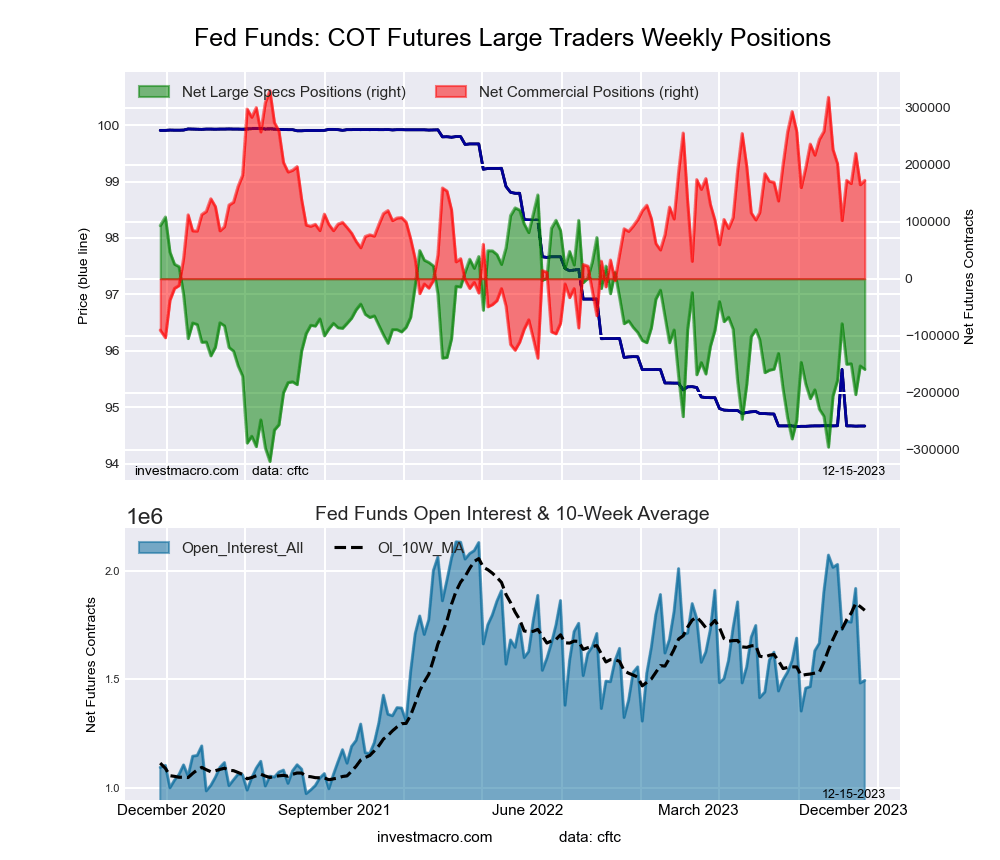 The 30-Day Federal Funds large speculator standing this week came in at a net position of -159,197 contracts in the data reported through Tuesday. This was a weekly decrease of -6,043 contracts from the previous week which had a total of -153,154 net contracts.
The 30-Day Federal Funds large speculator standing this week came in at a net position of -159,197 contracts in the data reported through Tuesday. This was a weekly decrease of -6,043 contracts from the previous week which had a total of -153,154 net contracts.
This week’s current strength score (the trader positioning range over the past three years, measured from 0 to 100) shows the speculators are currently Bearish with a score of 34.5 percent. The commercials are Bullish with a score of 66.4 percent and the small traders (not shown in chart) are Bullish with a score of 64.5 percent.
Price Trend-Following Model: Downtrend
Our weekly trend-following model classifies the current market price position as: Downtrend. The current action for the model is considered to be: Hold – Maintain Short Position.
| 30-Day Federal Funds Statistics | SPECULATORS | COMMERCIALS | SMALL TRADERS |
| – Percent of Open Interest Longs: | 8.7 | 75.9 | 2.0 |
| – Percent of Open Interest Shorts: | 19.4 | 64.3 | 2.9 |
| – Net Position: | -159,197 | 172,723 | -13,526 |
| – Gross Longs: | 129,934 | 1,133,265 | 30,437 |
| – Gross Shorts: | 289,131 | 960,542 | 43,963 |
| – Long to Short Ratio: | 0.4 to 1 | 1.2 to 1 | 0.7 to 1 |
| NET POSITION TREND: | |||
| – Strength Index Score (3 Year Range Pct): | 34.5 | 66.4 | 64.5 |
| – Strength Index Reading (3 Year Range): | Bearish | Bullish | Bullish |
| NET POSITION MOVEMENT INDEX: | |||
| – 6-Week Change in Strength Index: | 4.0 | -6.2 | 20.4 |
2-Year Treasury Note Futures:
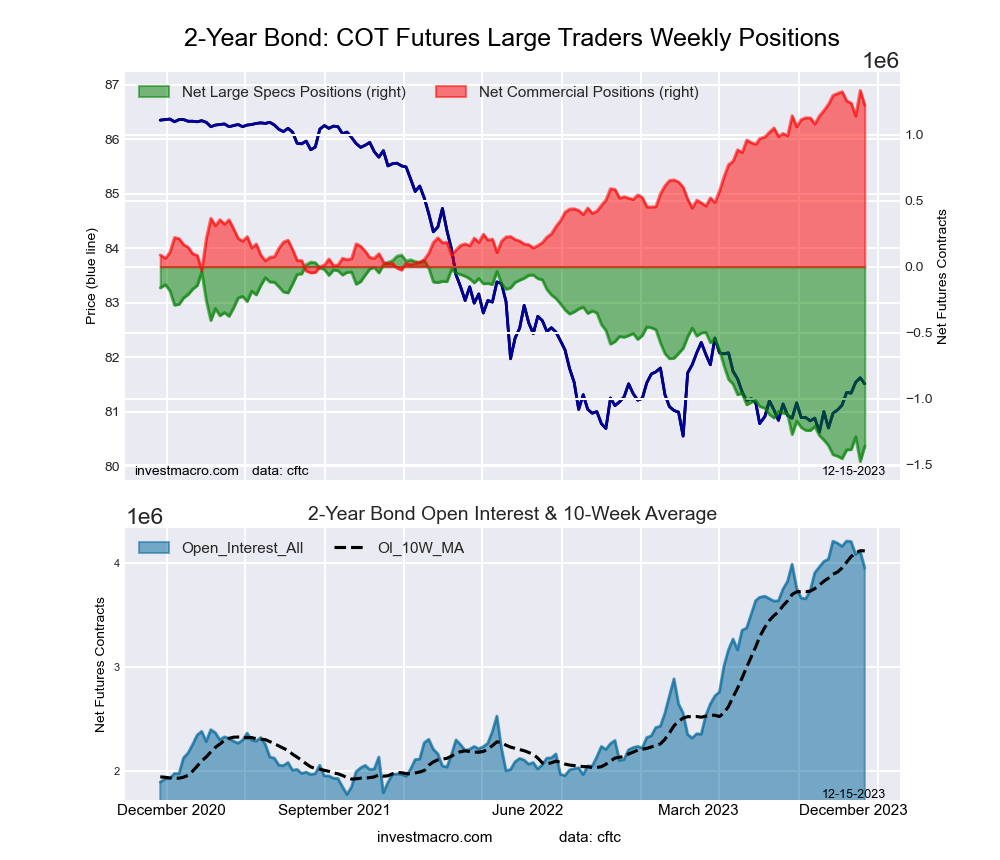 The 2-Year Treasury Note large speculator standing this week came in at a net position of -1,359,474 contracts in the data reported through Tuesday. This was a weekly boost of 116,542 contracts from the previous week which had a total of -1,476,016 net contracts.
The 2-Year Treasury Note large speculator standing this week came in at a net position of -1,359,474 contracts in the data reported through Tuesday. This was a weekly boost of 116,542 contracts from the previous week which had a total of -1,476,016 net contracts.
This week’s current strength score (the trader positioning range over the past three years, measured from 0 to 100) shows the speculators are currently Bearish-Extreme with a score of 7.5 percent. The commercials are Bullish-Extreme with a score of 91.9 percent and the small traders (not shown in chart) are Bullish-Extreme with a score of 95.8 percent.
Price Trend-Following Model: Strong Uptrend
Our weekly trend-following model classifies the current market price position as: Strong Uptrend. The current action for the model is considered to be: Hold – Maintain Long Position.
| 2-Year Treasury Note Statistics | SPECULATORS | COMMERCIALS | SMALL TRADERS |
| – Percent of Open Interest Longs: | 10.3 | 81.6 | 6.6 |
| – Percent of Open Interest Shorts: | 44.7 | 50.6 | 3.2 |
| – Net Position: | -1,359,474 | 1,223,113 | 136,361 |
| – Gross Longs: | 405,799 | 3,222,184 | 261,377 |
| – Gross Shorts: | 1,765,273 | 1,999,071 | 125,016 |
| – Long to Short Ratio: | 0.2 to 1 | 1.6 to 1 | 2.1 to 1 |
| NET POSITION TREND: | |||
| – Strength Index Score (3 Year Range Pct): | 7.5 | 91.9 | 95.8 |
| – Strength Index Reading (3 Year Range): | Bearish-Extreme | Bullish-Extreme | Bullish-Extreme |
| NET POSITION MOVEMENT INDEX: | |||
| – 6-Week Change in Strength Index: | 4.9 | -6.4 | 4.9 |
5-Year Treasury Note Futures:
 The 5-Year Treasury Note large speculator standing this week came in at a net position of -1,340,120 contracts in the data reported through Tuesday. This was a weekly lift of 89,307 contracts from the previous week which had a total of -1,429,427 net contracts.
The 5-Year Treasury Note large speculator standing this week came in at a net position of -1,340,120 contracts in the data reported through Tuesday. This was a weekly lift of 89,307 contracts from the previous week which had a total of -1,429,427 net contracts.
This week’s current strength score (the trader positioning range over the past three years, measured from 0 to 100) shows the speculators are currently Bearish-Extreme with a score of 8.2 percent. The commercials are Bullish-Extreme with a score of 90.6 percent and the small traders (not shown in chart) are Bullish-Extreme with a score of 95.9 percent.
Price Trend-Following Model: Strong Uptrend
Our weekly trend-following model classifies the current market price position as: Strong Uptrend. The current action for the model is considered to be: New Buy – Long Position.
| 5-Year Treasury Note Statistics | SPECULATORS | COMMERCIALS | SMALL TRADERS |
| – Percent of Open Interest Longs: | 8.0 | 83.5 | 7.5 |
| – Percent of Open Interest Shorts: | 31.4 | 62.5 | 5.1 |
| – Net Position: | -1,340,120 | 1,206,871 | 133,249 |
| – Gross Longs: | 460,211 | 4,790,468 | 427,616 |
| – Gross Shorts: | 1,800,331 | 3,583,597 | 294,367 |
| – Long to Short Ratio: | 0.3 to 1 | 1.3 to 1 | 1.5 to 1 |
| NET POSITION TREND: | |||
| – Strength Index Score (3 Year Range Pct): | 8.2 | 90.6 | 95.9 |
| – Strength Index Reading (3 Year Range): | Bearish-Extreme | Bullish-Extreme | Bullish-Extreme |
| NET POSITION MOVEMENT INDEX: | |||
| – 6-Week Change in Strength Index: | -9.5 | 7.0 | 11.8 |
10-Year Treasury Note Futures:
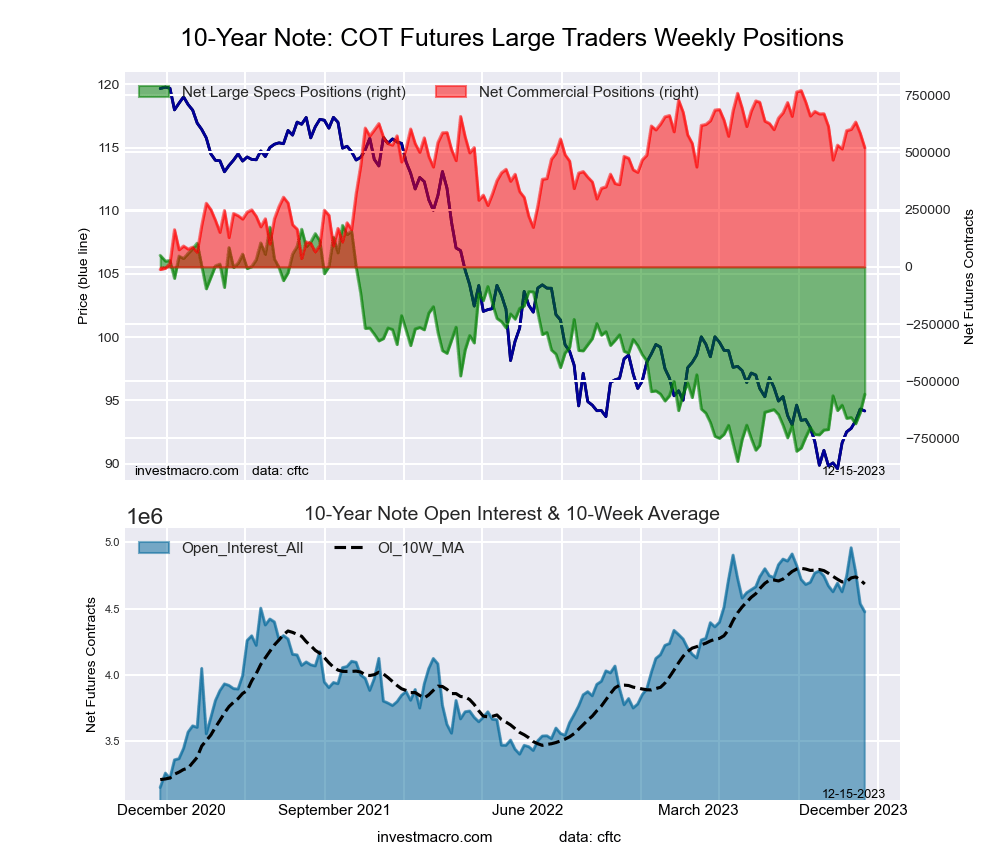 The 10-Year Treasury Note large speculator standing this week came in at a net position of -556,931 contracts in the data reported through Tuesday. This was a weekly increase of 79,525 contracts from the previous week which had a total of -636,456 net contracts.
The 10-Year Treasury Note large speculator standing this week came in at a net position of -556,931 contracts in the data reported through Tuesday. This was a weekly increase of 79,525 contracts from the previous week which had a total of -636,456 net contracts.
This week’s current strength score (the trader positioning range over the past three years, measured from 0 to 100) shows the speculators are currently Bearish with a score of 28.4 percent. The commercials are Bullish with a score of 68.0 percent and the small traders (not shown in chart) are Bullish-Extreme with a score of 81.4 percent.
Price Trend-Following Model: Weak Downtrend (Possible Trend Change)
Our weekly trend-following model classifies the current market price position as: Weak Downtrend. The current action for the model is considered to be: Hold – Maintain Short Position.
| 10-Year Treasury Note Statistics | SPECULATORS | COMMERCIALS | SMALL TRADERS |
| – Percent of Open Interest Longs: | 11.5 | 78.2 | 8.8 |
| – Percent of Open Interest Shorts: | 23.9 | 66.6 | 8.0 |
| – Net Position: | -556,931 | 520,684 | 36,247 |
| – Gross Longs: | 513,976 | 3,501,136 | 392,754 |
| – Gross Shorts: | 1,070,907 | 2,980,452 | 356,507 |
| – Long to Short Ratio: | 0.5 to 1 | 1.2 to 1 | 1.1 to 1 |
| NET POSITION TREND: | |||
| – Strength Index Score (3 Year Range Pct): | 28.4 | 68.0 | 81.4 |
| – Strength Index Reading (3 Year Range): | Bearish | Bullish | Bullish-Extreme |
| NET POSITION MOVEMENT INDEX: | |||
| – 6-Week Change in Strength Index: | 6.9 | -1.4 | -12.9 |
Ultra 10-Year Notes Futures:
 The Ultra 10-Year Notes large speculator standing this week came in at a net position of -276,476 contracts in the data reported through Tuesday. This was a weekly decline of -8,621 contracts from the previous week which had a total of -267,855 net contracts.
The Ultra 10-Year Notes large speculator standing this week came in at a net position of -276,476 contracts in the data reported through Tuesday. This was a weekly decline of -8,621 contracts from the previous week which had a total of -267,855 net contracts.
This week’s current strength score (the trader positioning range over the past three years, measured from 0 to 100) shows the speculators are currently Bearish-Extreme with a score of 0.0 percent. The commercials are Bullish-Extreme with a score of 100.0 percent and the small traders (not shown in chart) are Bullish with a score of 74.8 percent.
Price Trend-Following Model: Weak Uptrend (Possible Trend Change)
Our weekly trend-following model classifies the current market price position as: Weak Uptrend. The current action for the model is considered to be: Hold – Maintain Long Position.
| Ultra 10-Year Notes Statistics | SPECULATORS | COMMERCIALS | SMALL TRADERS |
| – Percent of Open Interest Longs: | 10.8 | 78.4 | 10.2 |
| – Percent of Open Interest Shorts: | 24.8 | 61.1 | 13.6 |
| – Net Position: | -276,476 | 342,405 | -65,929 |
| – Gross Longs: | 214,045 | 1,553,719 | 203,035 |
| – Gross Shorts: | 490,521 | 1,211,314 | 268,964 |
| – Long to Short Ratio: | 0.4 to 1 | 1.3 to 1 | 0.8 to 1 |
| NET POSITION TREND: | |||
| – Strength Index Score (3 Year Range Pct): | 0.0 | 100.0 | 74.8 |
| – Strength Index Reading (3 Year Range): | Bearish-Extreme | Bullish-Extreme | Bullish |
| NET POSITION MOVEMENT INDEX: | |||
| – 6-Week Change in Strength Index: | -4.4 | 11.8 | -20.7 |
US Treasury Bonds Futures:
 The US Treasury Bonds large speculator standing this week came in at a net position of -136,259 contracts in the data reported through Tuesday. This was a weekly reduction of -6,180 contracts from the previous week which had a total of -130,079 net contracts.
The US Treasury Bonds large speculator standing this week came in at a net position of -136,259 contracts in the data reported through Tuesday. This was a weekly reduction of -6,180 contracts from the previous week which had a total of -130,079 net contracts.
This week’s current strength score (the trader positioning range over the past three years, measured from 0 to 100) shows the speculators are currently Bearish with a score of 36.0 percent. The commercials are Bearish with a score of 48.5 percent and the small traders (not shown in chart) are Bullish with a score of 74.4 percent.
Price Trend-Following Model: Weak Downtrend (Possible Trend Change)
Our weekly trend-following model classifies the current market price position as: Weak Downtrend. The current action for the model is considered to be: Hold – Maintain Short Position.
| US Treasury Bonds Statistics | SPECULATORS | COMMERCIALS | SMALL TRADERS |
| – Percent of Open Interest Longs: | 9.3 | 76.2 | 14.1 |
| – Percent of Open Interest Shorts: | 19.7 | 68.5 | 11.4 |
| – Net Position: | -136,259 | 100,575 | 35,684 |
| – Gross Longs: | 121,982 | 996,728 | 184,452 |
| – Gross Shorts: | 258,241 | 896,153 | 148,768 |
| – Long to Short Ratio: | 0.5 to 1 | 1.1 to 1 | 1.2 to 1 |
| NET POSITION TREND: | |||
| – Strength Index Score (3 Year Range Pct): | 36.0 | 48.5 | 74.4 |
| – Strength Index Reading (3 Year Range): | Bearish | Bearish | Bullish |
| NET POSITION MOVEMENT INDEX: | |||
| – 6-Week Change in Strength Index: | 6.7 | -0.2 | -13.5 |
Ultra US Treasury Bonds Futures:
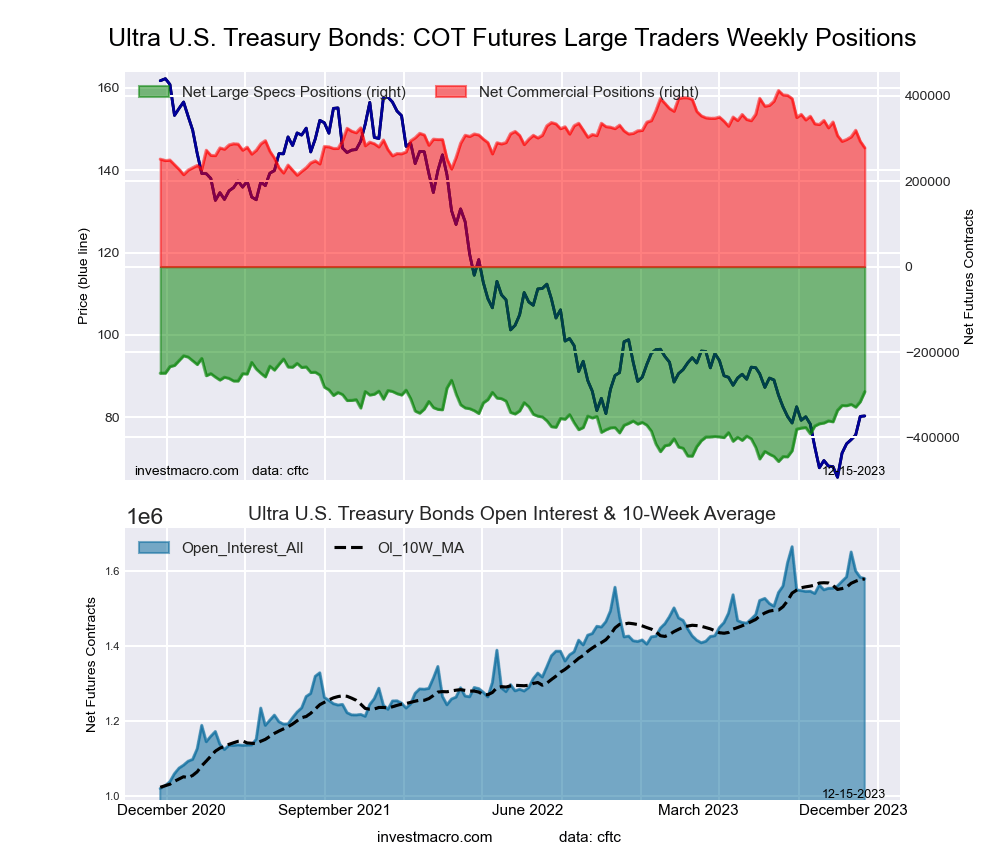 The Ultra US Treasury Bonds large speculator standing this week came in at a net position of -292,980 contracts in the data reported through Tuesday. This was a weekly gain of 23,682 contracts from the previous week which had a total of -316,662 net contracts.
The Ultra US Treasury Bonds large speculator standing this week came in at a net position of -292,980 contracts in the data reported through Tuesday. This was a weekly gain of 23,682 contracts from the previous week which had a total of -316,662 net contracts.
This week’s current strength score (the trader positioning range over the past three years, measured from 0 to 100) shows the speculators are currently Bullish with a score of 66.0 percent. The commercials are Bearish with a score of 32.3 percent and the small traders (not shown in chart) are Bullish with a score of 51.0 percent.
Price Trend-Following Model: Weak Downtrend (Possible Trend Change)
Our weekly trend-following model classifies the current market price position as: Weak Downtrend. The current action for the model is considered to be: Hold – Maintain Short Position.
| Ultra US Treasury Bonds Statistics | SPECULATORS | COMMERCIALS | SMALL TRADERS |
| – Percent of Open Interest Longs: | 7.3 | 81.7 | 10.7 |
| – Percent of Open Interest Shorts: | 25.9 | 64.0 | 9.8 |
| – Net Position: | -292,980 | 278,286 | 14,694 |
| – Gross Longs: | 115,577 | 1,290,226 | 169,381 |
| – Gross Shorts: | 408,557 | 1,011,940 | 154,687 |
| – Long to Short Ratio: | 0.3 to 1 | 1.3 to 1 | 1.1 to 1 |
| NET POSITION TREND: | |||
| – Strength Index Score (3 Year Range Pct): | 66.0 | 32.3 | 51.0 |
| – Strength Index Reading (3 Year Range): | Bullish | Bearish | Bullish |
| NET POSITION MOVEMENT INDEX: | |||
| – 6-Week Change in Strength Index: | 17.6 | -14.5 | -13.9 |
Article By InvestMacro – Receive our weekly COT Newsletter
*COT Report: The COT data, released weekly to the public each Friday, is updated through the most recent Tuesday (data is 3 days old) and shows a quick view of how large speculators or non-commercials (for-profit traders) were positioned in the futures markets.
The CFTC categorizes trader positions according to commercial hedgers (traders who use futures contracts for hedging as part of the business), non-commercials (large traders who speculate to realize trading profits) and nonreportable traders (usually small traders/speculators) as well as their open interest (contracts open in the market at time of reporting). See CFTC criteria here.

